After our last stop in Northern Patagonia, in Bariloche, we took the bus to the Argentinian capital – Buenos Aires! After that we went further north …
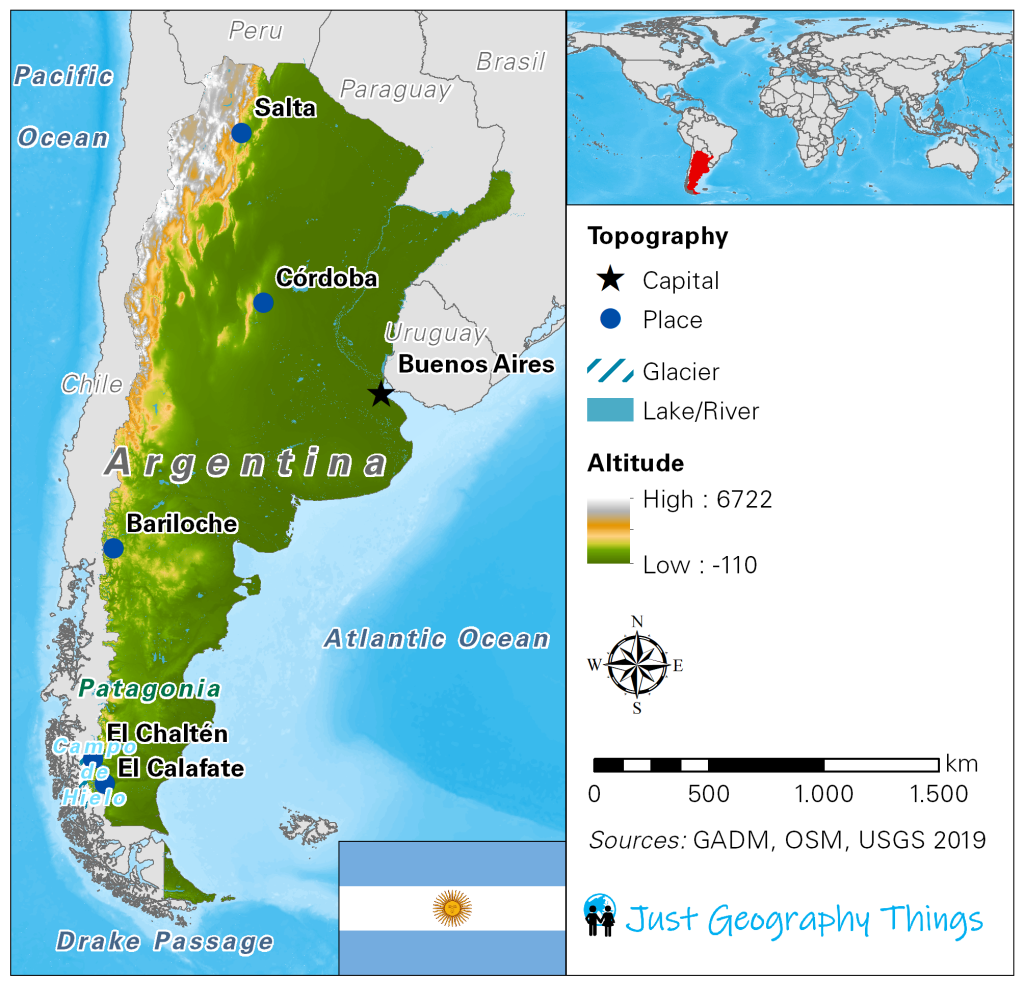
Bariloche (25.01. -27.01.20)
Bariloche is a slightly larger city by Patagonian standards and has a population of over 150,000. The city is not really beautiful, but it is located between the two sectors of the Parque Nacional Nahuel-Huapi at the lake of the same name and surrounded by mountains. We look for a campground which is quiet but still close to the city and meet Marcel and Anne again, who we had already met in El Chaltén. Together we decide to hike the Quatro Refugio Trek.
In Bariloche itself we are mainly occupied with food and old acquaintances. With Deniz and Seb, who we had met in Puerto Varas, we go for a real steak dinner – Argentinian beef! To say that it was the best steak of our lives would be a dramatic understatement.

At first we were deterred by the prices. When asked how much gram a steak weighs, the answer is of course 600 grams. Thus also our price concern has settled and we share in twos a steak in each case. For Diana and me it was definitely the best steak we ever had and we have never cut smaller pieces of anything to have something for as long as possible.
In addition, Bariloche, like many other small towns in Patagonia, is known for a diverse microbrewing scene. We have heard good things about the Manush Brewery and therefore visit it three times at happy hour!
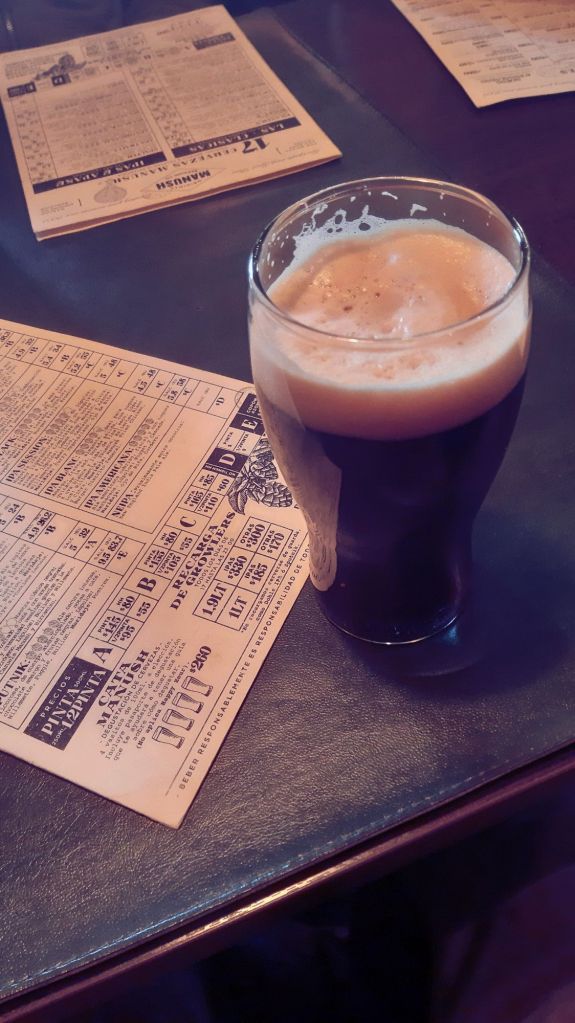

Otherwise we use Bariloche to get money and organize the usual things, because the best thing about the city is definitely the surroundings, like the Quatro Refugio Trek and the small village Colonia Suiza.
Quatro Refugio Trek (27.01. – 31.01.20)
After we met Marcel and Anne again in Bariloche, the decision was quickly made to take advantage of the good weather window and hike the Quatro Refugio Trek. We were immediately aware that there should be a tricky climbing spot, but nevertheless not until the third day and so we started at our campground in Los Coihues in bright sunshine, blue sky and warm temperatures to our first day’s destination – the Refugio Frey.
Day 1
Los Coihues to Refugio Frey – 12,6 km
The hike first leads along a lake, before we turn right over a wooded valley to gain altitude. Through the many gaps in the treetops we can catch beautiful views of the opposite mountainsides.
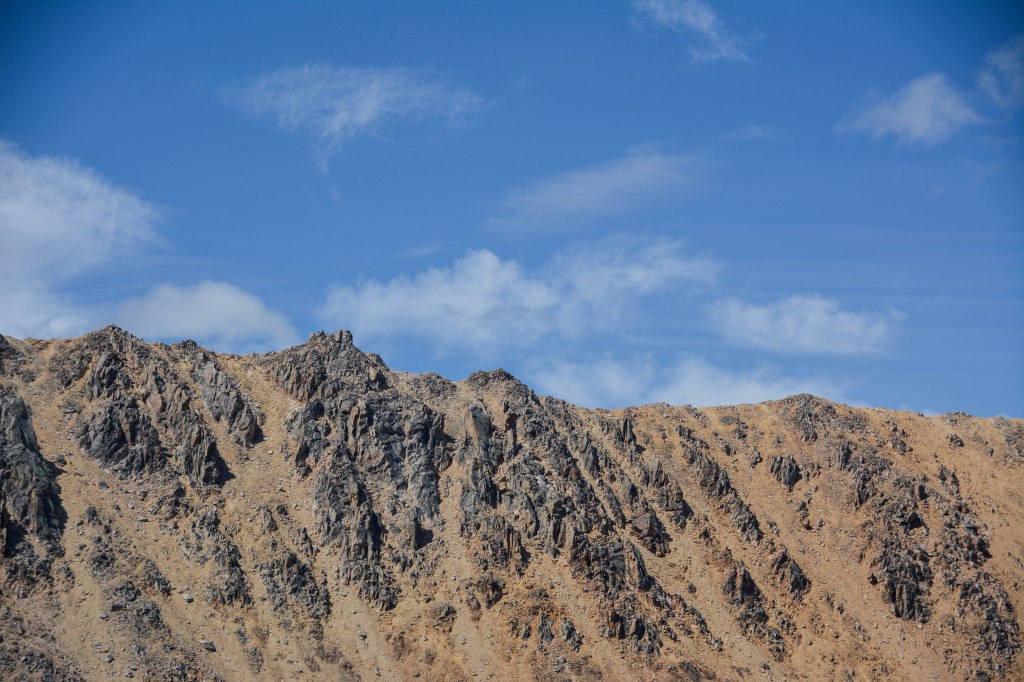

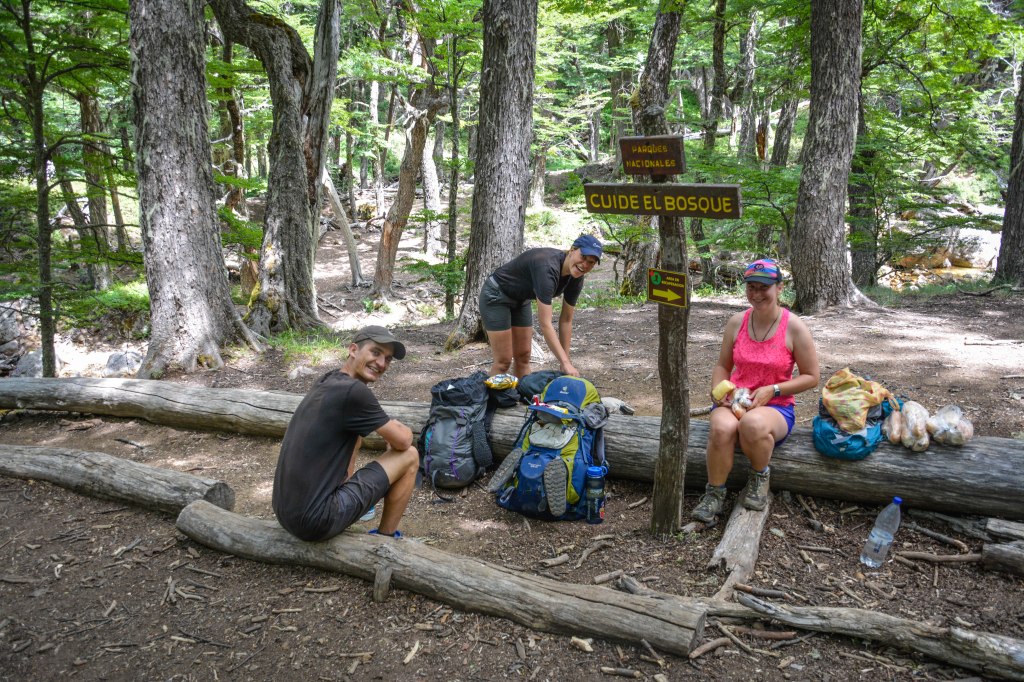
Arriving at Refugio Frey we have to wait two hours for certainty, because we have no reservation for the campground. While Lucas is looking for wild camping possibilities on the lakeshore and behind it, the others are watching the many rock climbers. The sharp and rugged mountains around the refugio offer not only a great scenery but also a huge climbing area with countless routes.
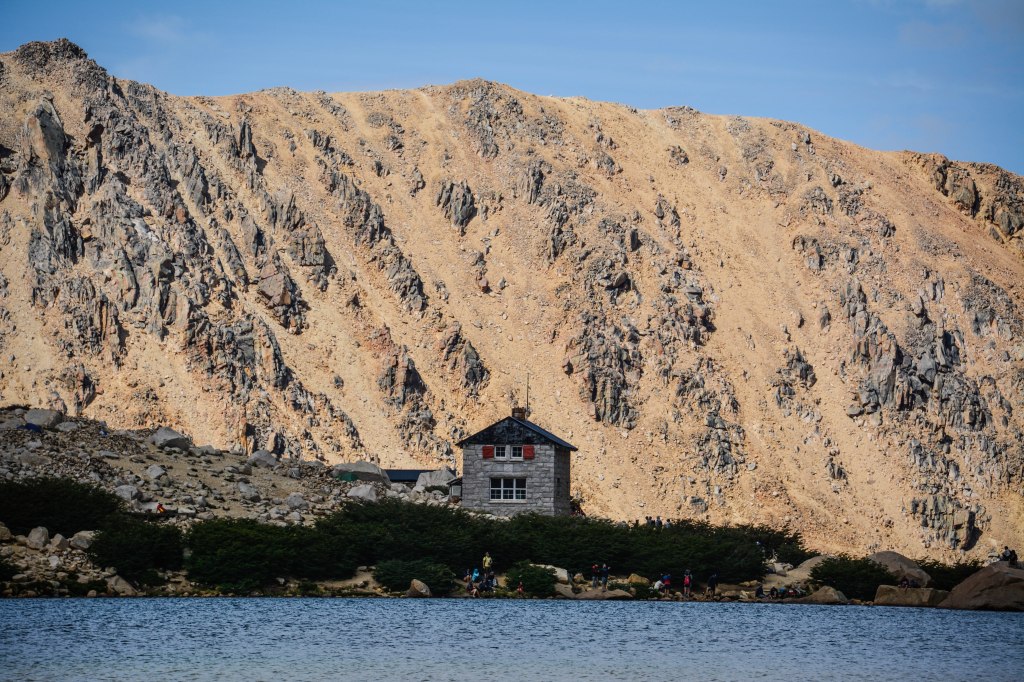
After 2 hours waiting time we had the certainty – we can pitch our tent at the designated place. But this should be a challenge. Some clever person had found that the ridge would be a suitable location when setting up the campground. That was probably on a windless day. On the stony ground we are not one hundred percent satisfied with the way we set up our tent, but it should be enough for one night.
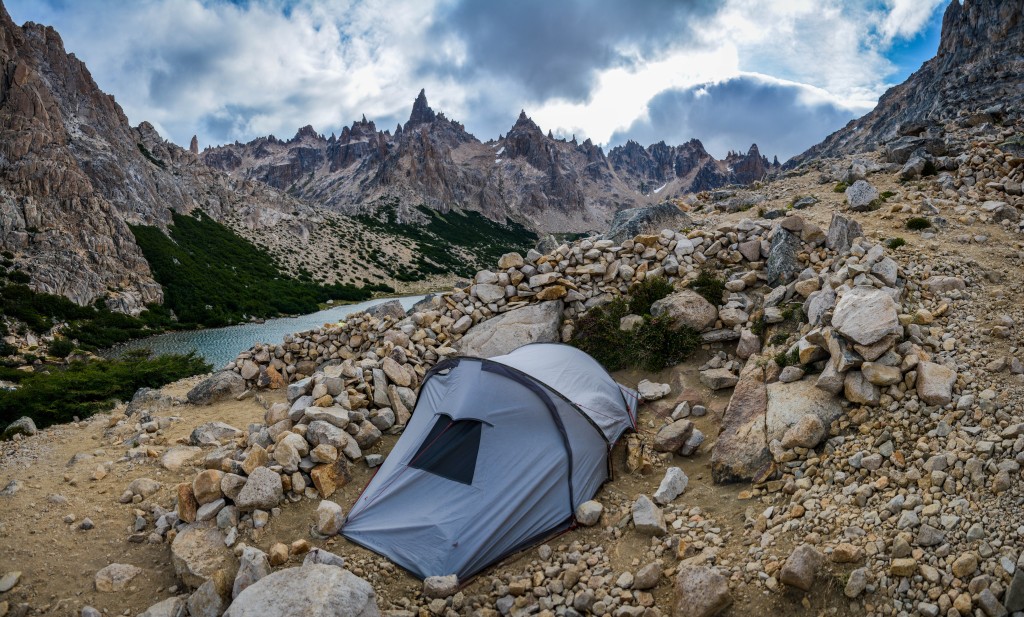
The common day room is so full that we only cook there and afterwards we meet in our tent to play Durak (in russian Дурак) and then also sleep already. Meanwhile, the sun goes down clearly earlier than still in the south of Patagonia and thus it was already dark at 21 o’clock.
After it was quite windless the whole day, the night would like to prove it. We often wake up at night and notice every time that we could not pitch our tent on the stony ground in an optimal way. The two tent poles are strongly worked by the forces of the wind, nevertheless, hold out well. One of the climbers had still said that at this refugio every week some tents „die“ and we were glad to have made a solid choice. Additionally a little rain set in – the only one predicted for the hike!
Day 2
Refugio Frey to Refugio San Martín – 8 km
After a not very restful night with little sleep we get up in the morning with very good weather. Both tents had survived the night and we can enjoy a great view in the morning!

As we get up early, the common cooking room is surprisingly empty and we can really spread out!
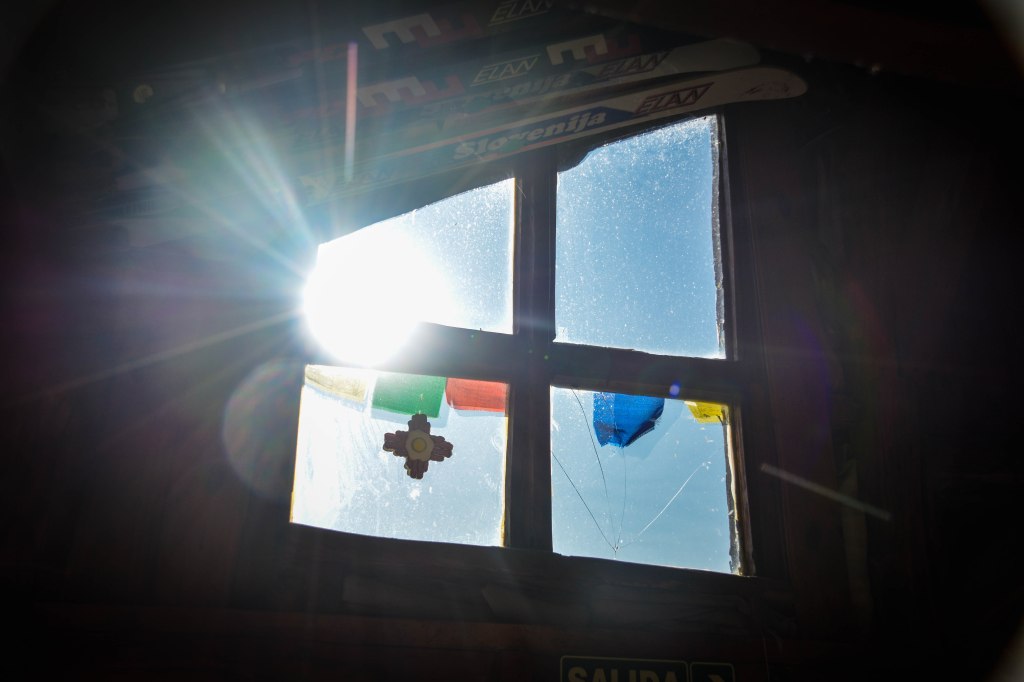
Today there are just 8 kilometres ahead of us, but it is predicted to be 5 hours. We still wonder about the indication and start walking in a good mood. After we have circumnavigated the lake, the first steep climb is already waiting for us!
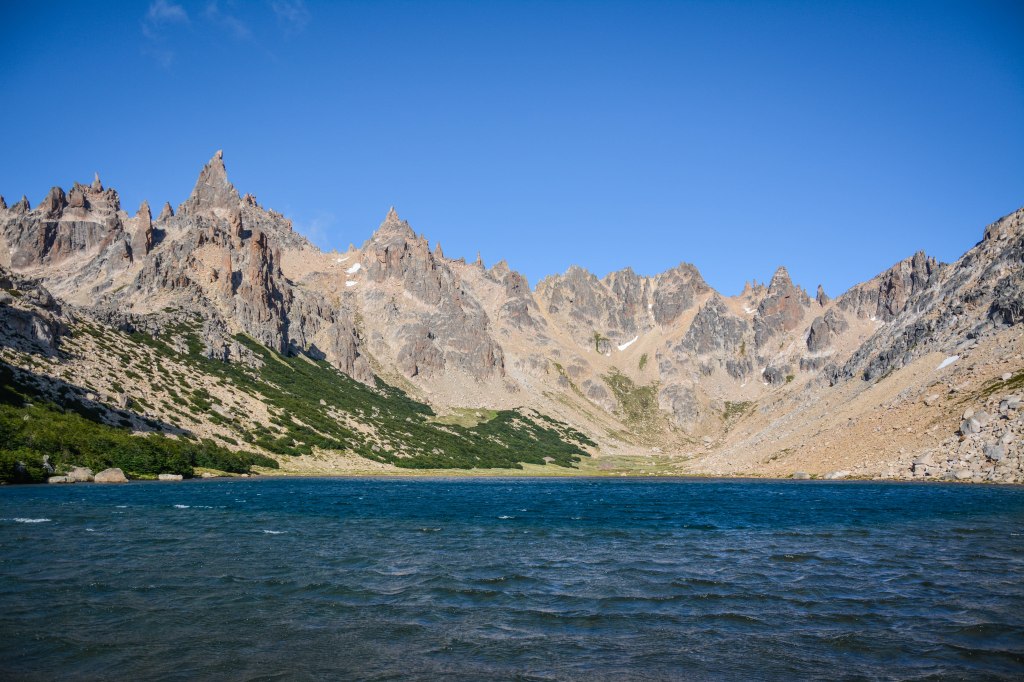

After a bit of clambering we successfully mastered the first climb of the day. Time for a group picture!
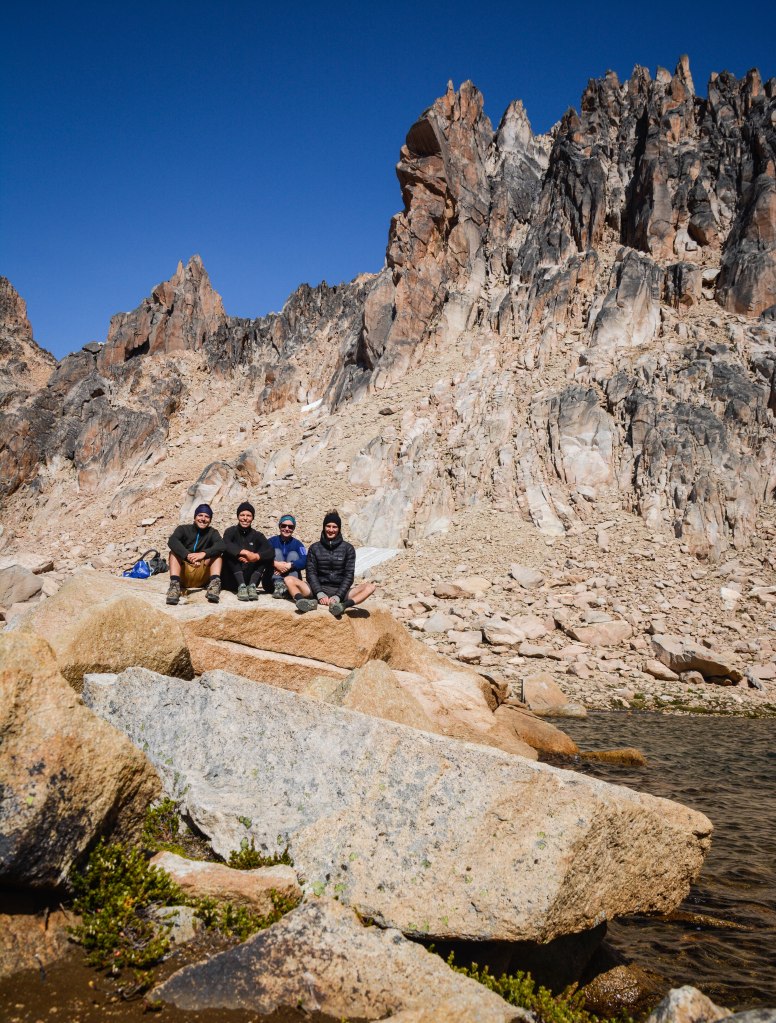
However, the track continues to ascend. The good mood is nevertheless always there!
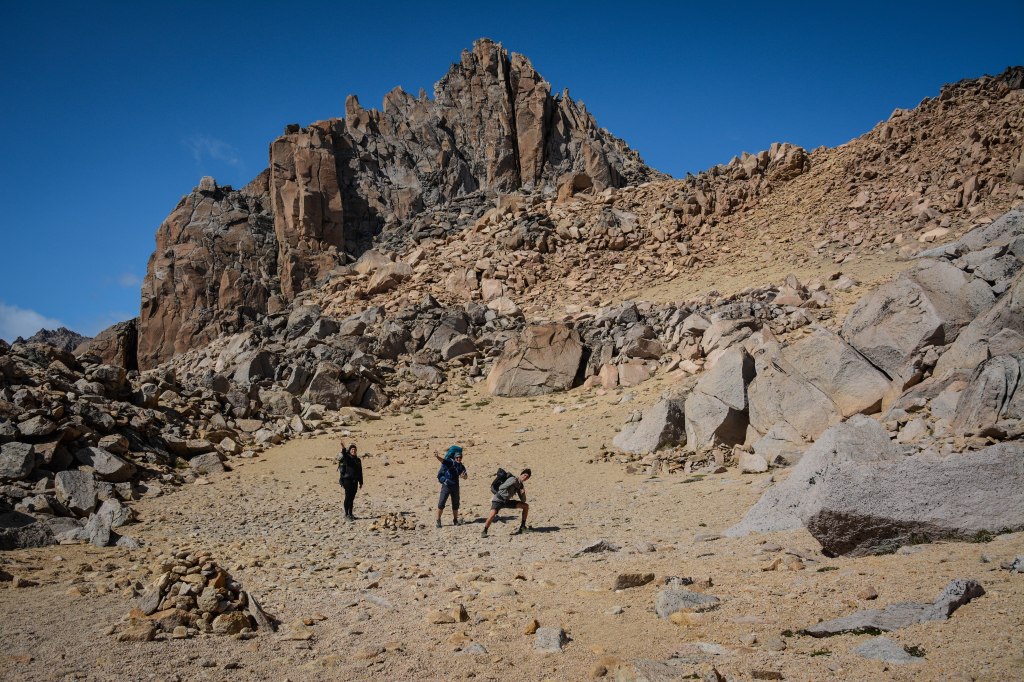

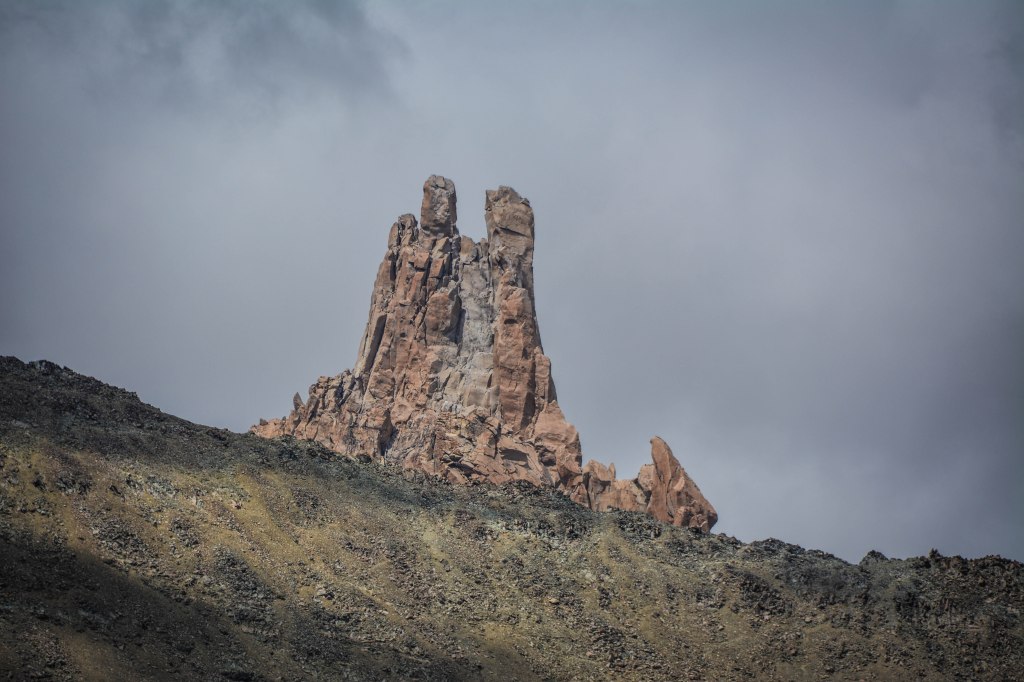

The area around Bariloche is defined by old glacial valleys, rivers and mountain ridges. For us this means in concrete terms that we have to cross another pass on today’s 8km long stage. No sooner said than done!
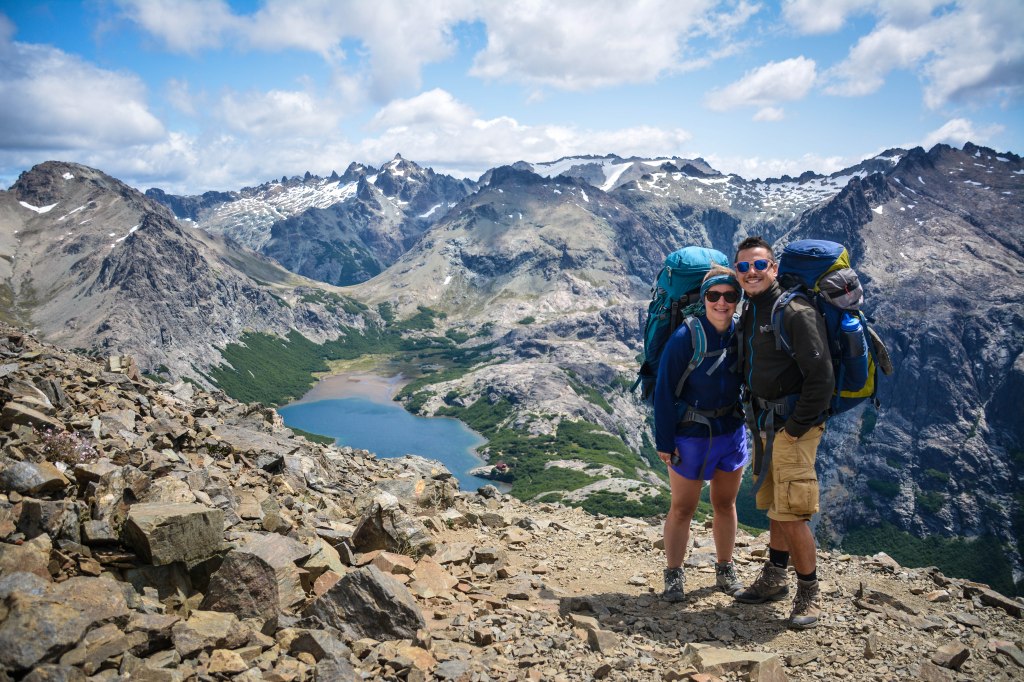
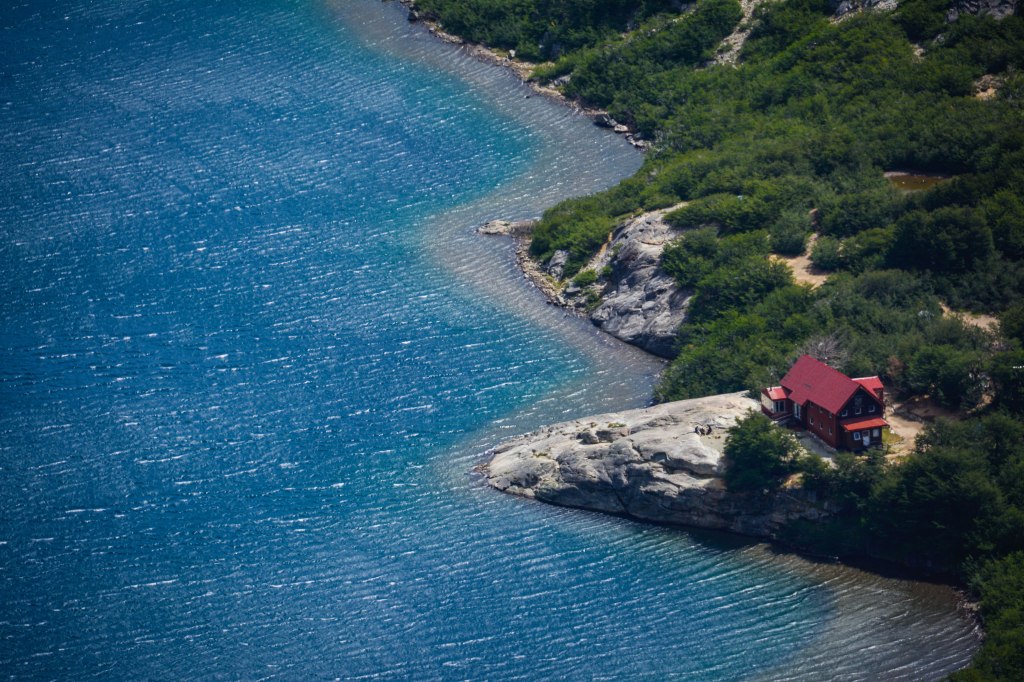
We also complete this daily stage and finally put up our tent again. At the windy lakeside we can enjoy a beautiful sunset for a short time.
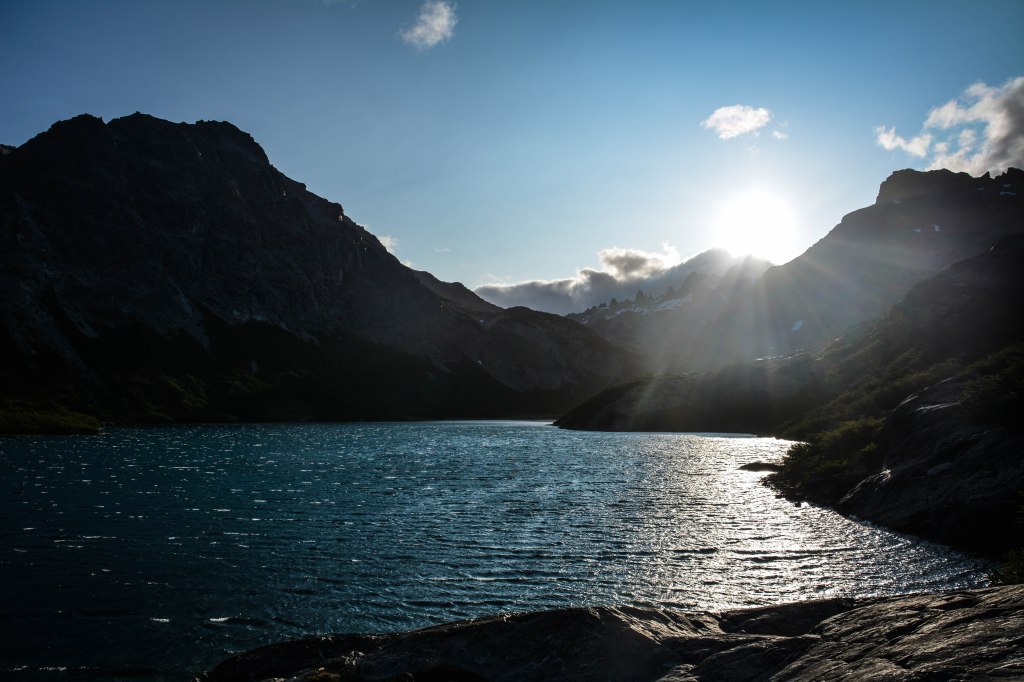

However, the tension rises noticeably – the next day includes a climbing piece that is exposed. We haven’t seen any pictures, just read a bit in hiking reports and they range from not very spectacular to dizzying. So we spend the evening discussing how we could possibly proceed, the spot getting too tricky. After the not very restful night at the Refugio Frey we fall asleep this time with many thoughts in our heads…
Day 3
Refugio San Martín to Refugio Manfredo Segre (Italiano) – 8,3 km
In the morning we successfully carry out our hiking routine again: Get up, pack sleeping bags, Diana cooks porridge and Lucas puts the tent together.
Shortly after 9 am there will be a short information session on the daily stage. A ranger will explain the way and the peculiarities. On the pictures the climb looks feasible, but this may differ from reality. On this sunny and windless day 8 people want to try the so-called Nahuel Huapi traverse. After the information session is over, we put our backpacks back on and off we go.
First we climb up over bare rock for about an hour before we arrive at a small rock plateau. The view is wide and undisturbed in every respect.

The view straight ahead as well as downwards is not disturbed and free from anything. The situation is obviously very unpleasant for Diana. It is simply too exposed and the awareness of the height is uncomfortable when looking down, so she does not want to continue the hike via the climbing section where you can look down. Marcel and Lucas accompany her down a bit so that clear thoughts can be recaptured and so we think about a good compromise solution.
The decision is difficult – Diana doesn’t want to go any further and find herself in an uncomfortable situation, but Lucas would like to continue the hike. At the same time we don’t want to leave each other alone in case something happens. After some time to think about it, we decide to go separate ways at this point. Diana goes through the valley at the Refugio San Martín towards Colonia Suiza and Lucas continues with Marcel and Anne. We have agreed to meet again the following day at the Refugio López, the destination of the penultimate stage of the day.
The next meters and minutes are not nice for either of us. There is a feeling of having let the other down and not knowing what will happen. For the first time since we went to the airport in Munich (on April 3, 2019) we are really separated. It feels strange and in the next few minutes we have to pull ourselves together.
Nevertheless, it goes on. Diana walks down the valley and has a nice day along the river, which is lined with many flowers. When she reaches the bottom she is even lucky and can hitchhike a small part of the way. Once in Colonia Suiza, Diana finds a nice place to stay and even has a whole cottage to herself.
For the rest of the hiking group there is still a physically demanding day ahead. The climbing section was successfully mastered and shortly afterwards we crossed another pass.

A real highlight of the hike was definitely the first summit that Marcel, Anne and Lucas reached later – the Cerro Navidad.

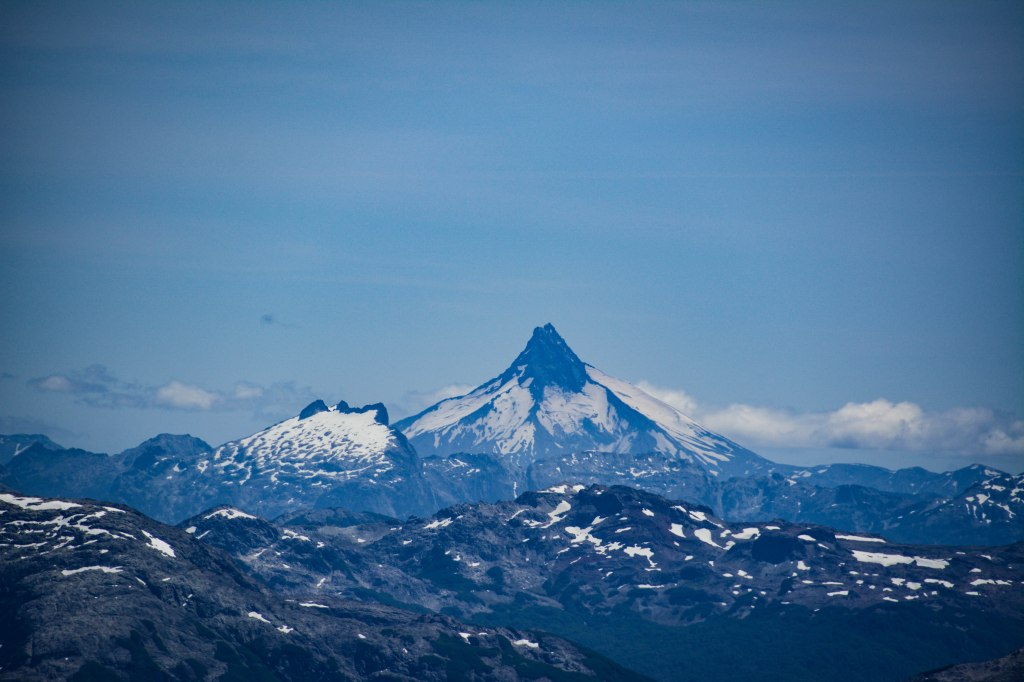
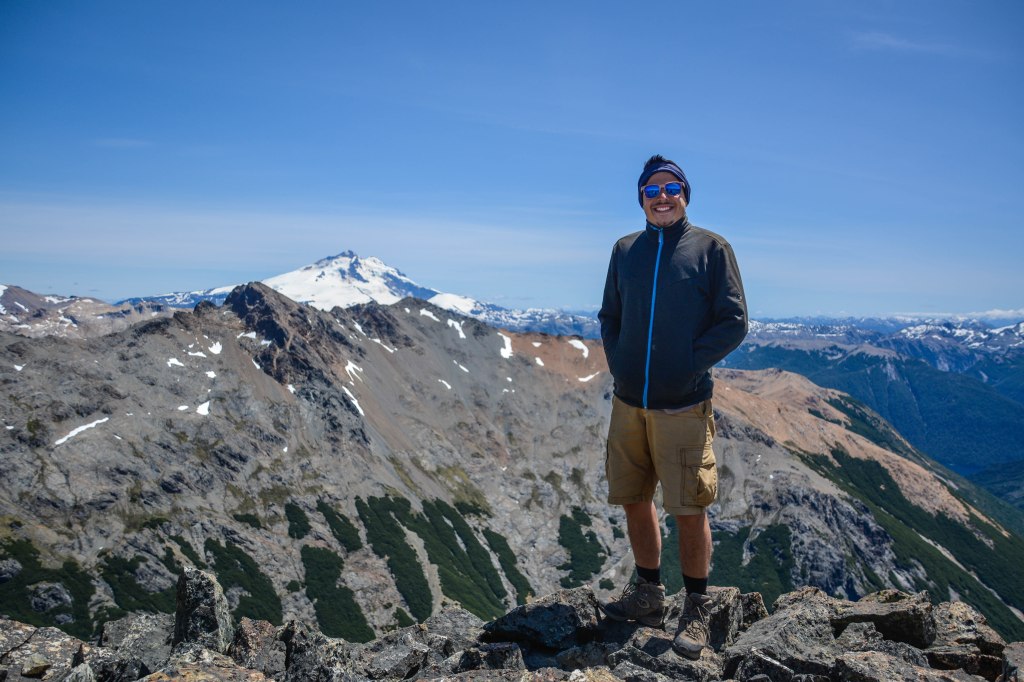
A long descent followed with a lot of loose scree and the crossing of several ice fields. The deeper it goes down into the valley, the more the air stands still and the hotter Lucas’s head gets. As far as the route is concerned, it is not far anymore. But on the last 900 meters of the route, more than 400 HM are still to be conquered. After half an hour of intensive sweating it was still done and the bright red Refugio Manfredo Segre was in front of Lucas eyes! Now the only thing left to do was to fulfill the dream of camping directly at the lakeside with spectacular views!

While commuting between tent and refugio we can see each time the descent we had already mastered that day.
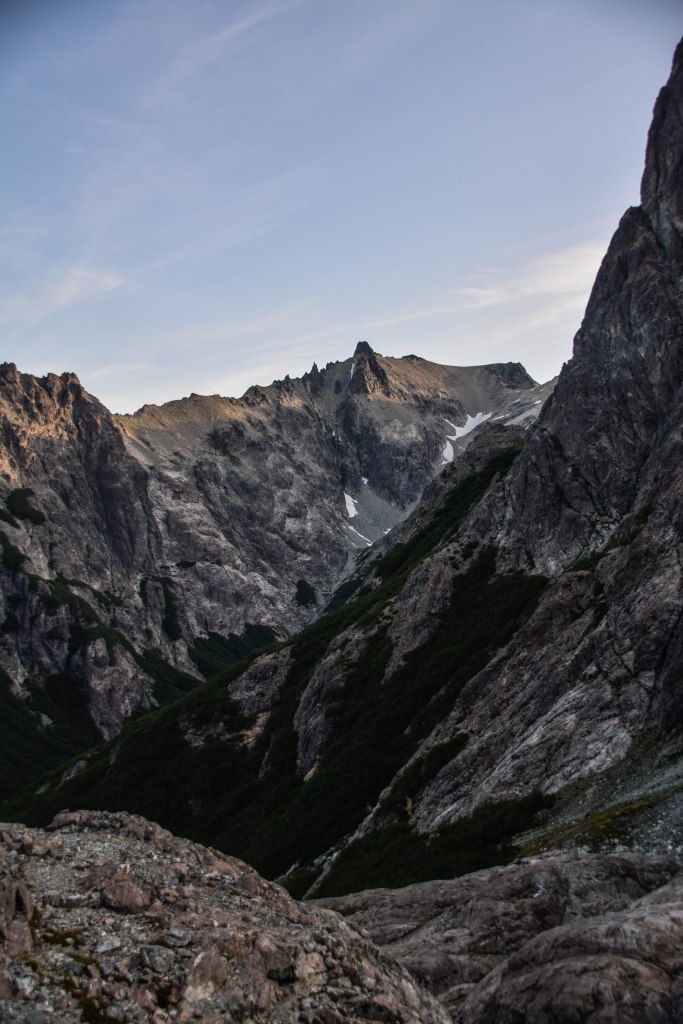


Although we were not together, we were faced with a common novelty – the first night of the journey, which we spent separately. While Diana could once again cover a bed, Lucas spread out in the 3-person tent. But it was unusual for both of us.
Day 4
Refugio Manfredo Segre to Refugio López – 7 km
Fortunately, however, the spatial separation was only of very limited duration, because it was only 7 km before Marcel, Anne and Lucas until we could see Diana again. As before every day we thought that it was only a short distance. Again today this should not be a measure of the missing effort of the stage. Quite the opposite.


At the beginning the etape winds along the Laguna Negra and we can see the refugio again in its full splendor.

Laguna Negra has quite steep banks and is very clear. You can see this very well when you walk by and wonder if Laguna Azul would have been a more appropriate name.
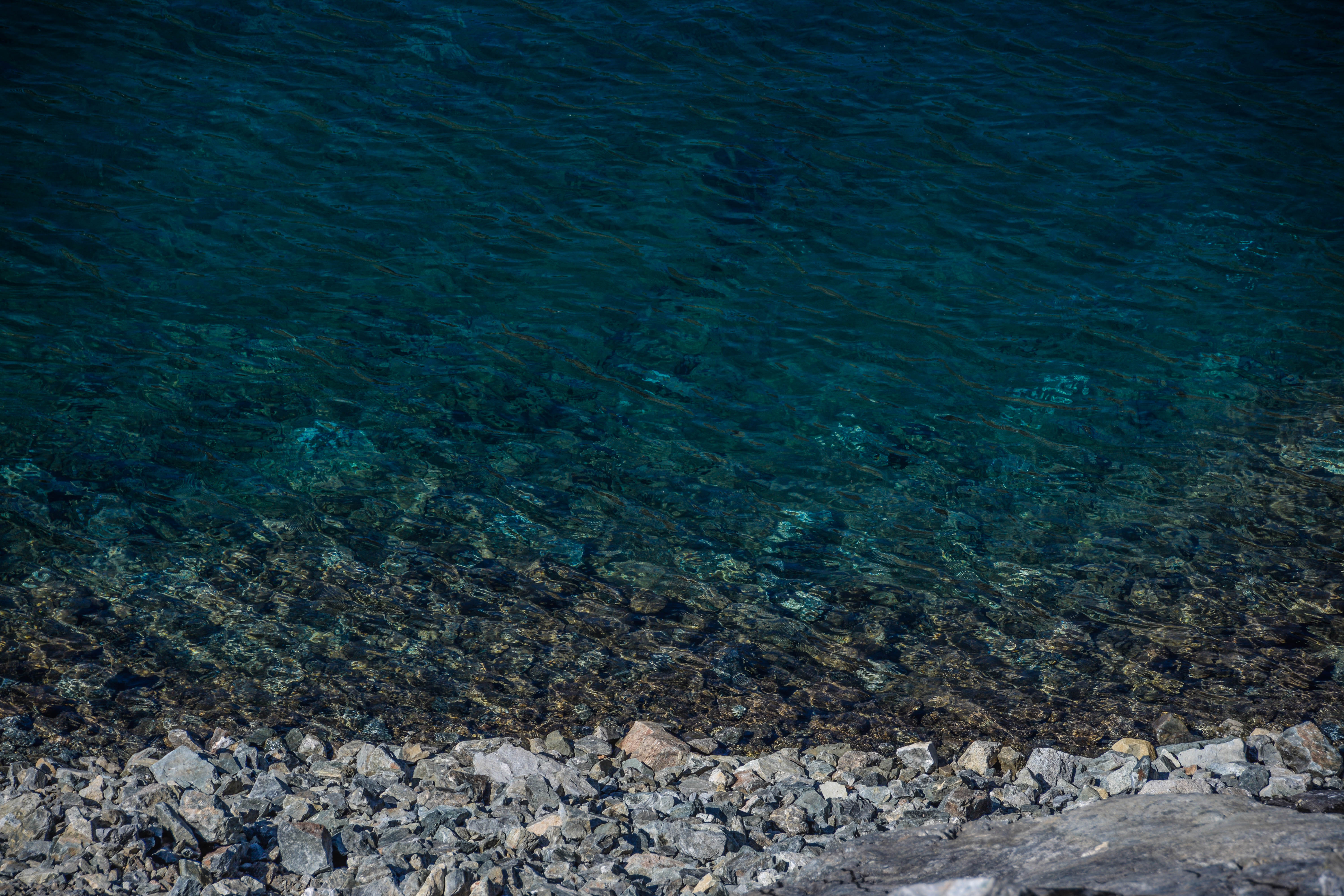
Then once again: Ascent! The first pass of the day with mountain top is coming up. This time we are heading towards Cerro Bailey Willis. The wildly piled up stones on the ridge remind us somehow of a microscopic view of cigarette butts.



We continue our descent and ask ourselves if we have ever walked through a flat piece on this hike. That down meant of course also that there had to be an up and we try with the map to find our destination summit, Cerro López. Meanwhile another hiking group is stuck on a very steep and stony slope and we joke that we don’t have to walk up there anyway.
We thought wrong. A few minutes later we realize that our map material was perhaps a little simplified and we were wrong. And already a first-class game of Kraxlpartie begins.
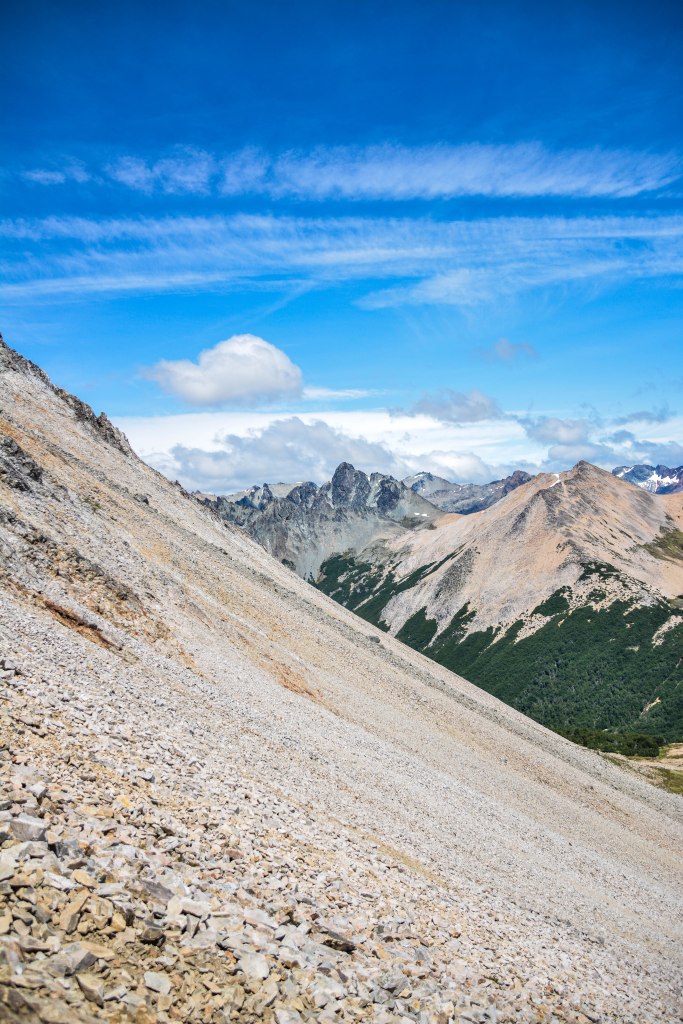
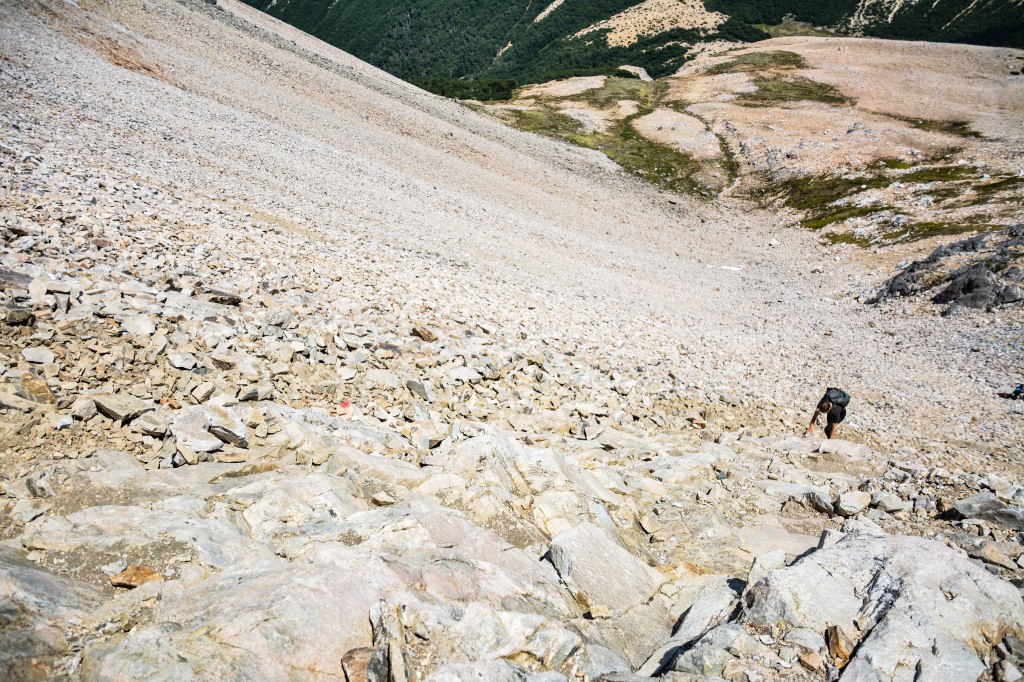
After we have mastered the part, the time has come and we stand on Cerro López – we are rewarded with a 360° view over Nahuel Huapi National Park, the lake of the same name and Bariloche.

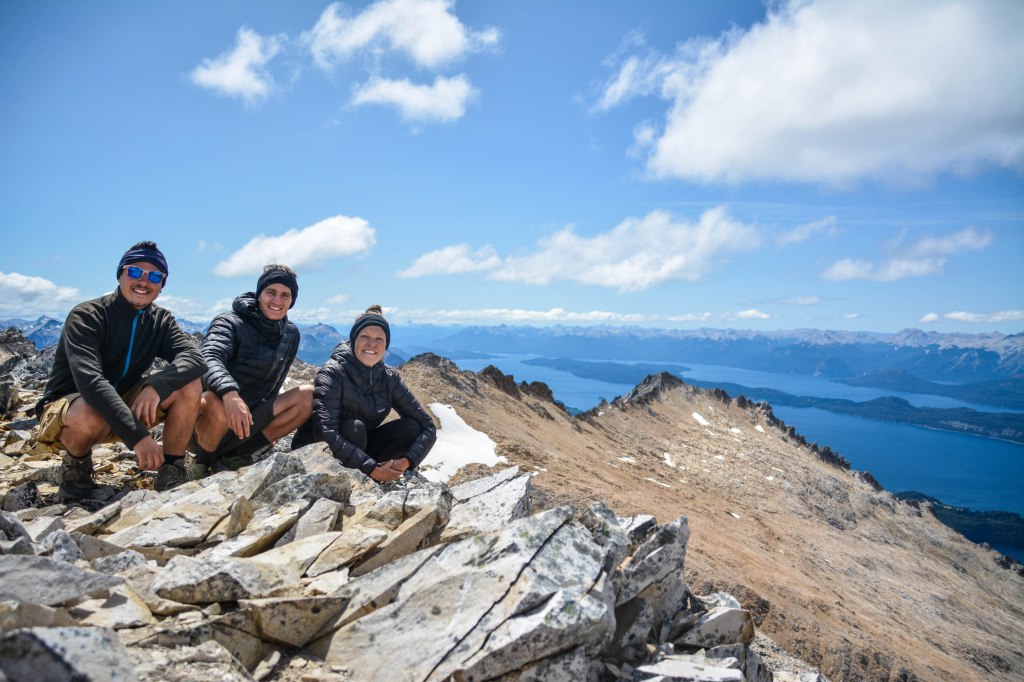
The descent is quickly completed as we meet Diana again at Refugio López! The joy is of course great when we finally get together again.
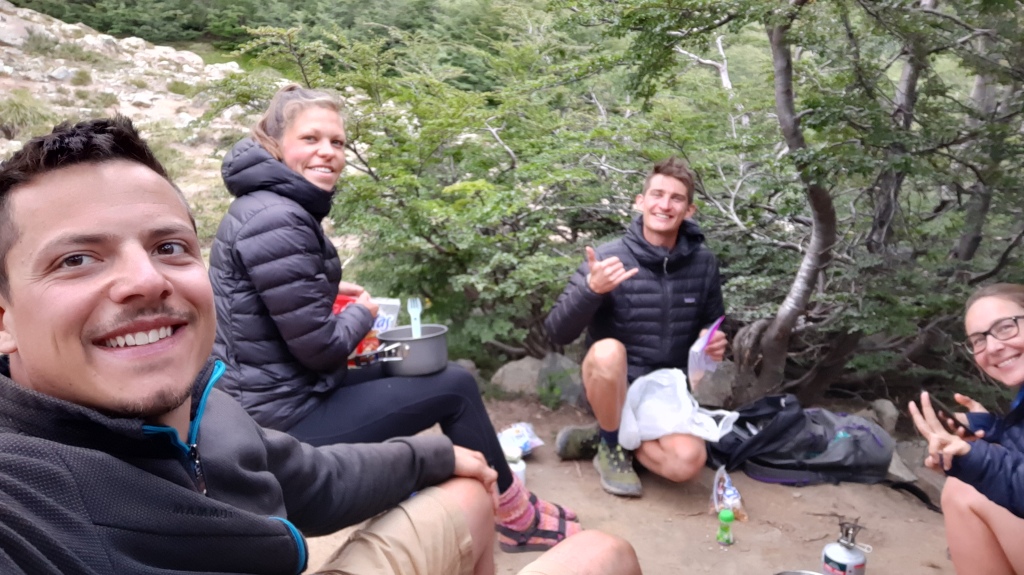
Day 5
Refugio López to Bariloche – 6,8 km
Actually, the distance would have been shorter, but we decide on the variant which is flatter to spare our knees after the strenuous days. Again with best weather we can enjoy views of Lago Nahuel Huapi.
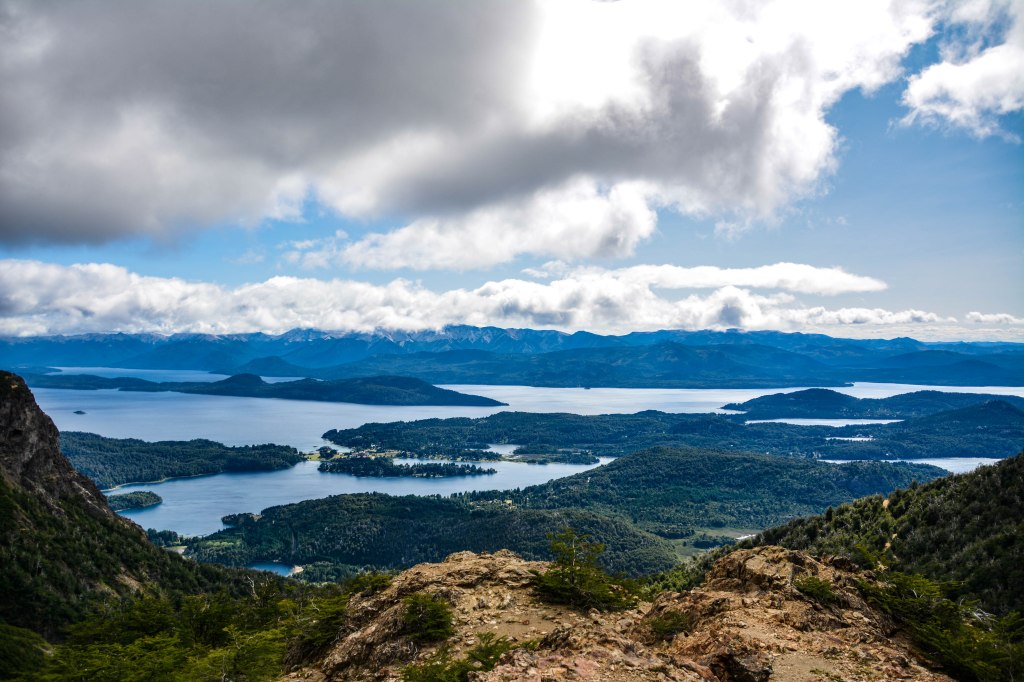
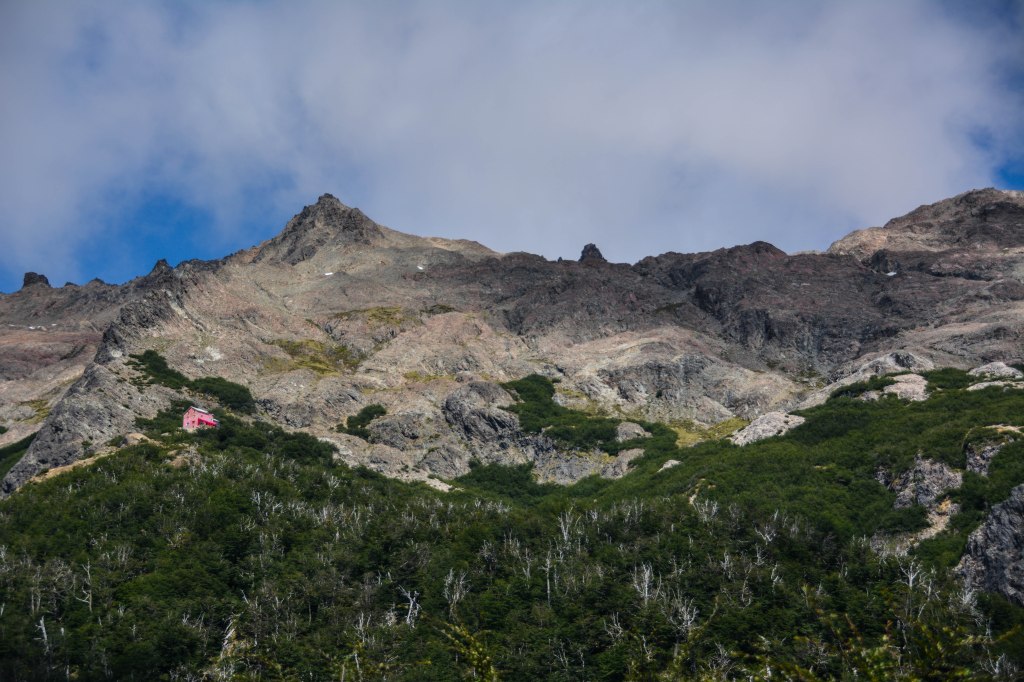
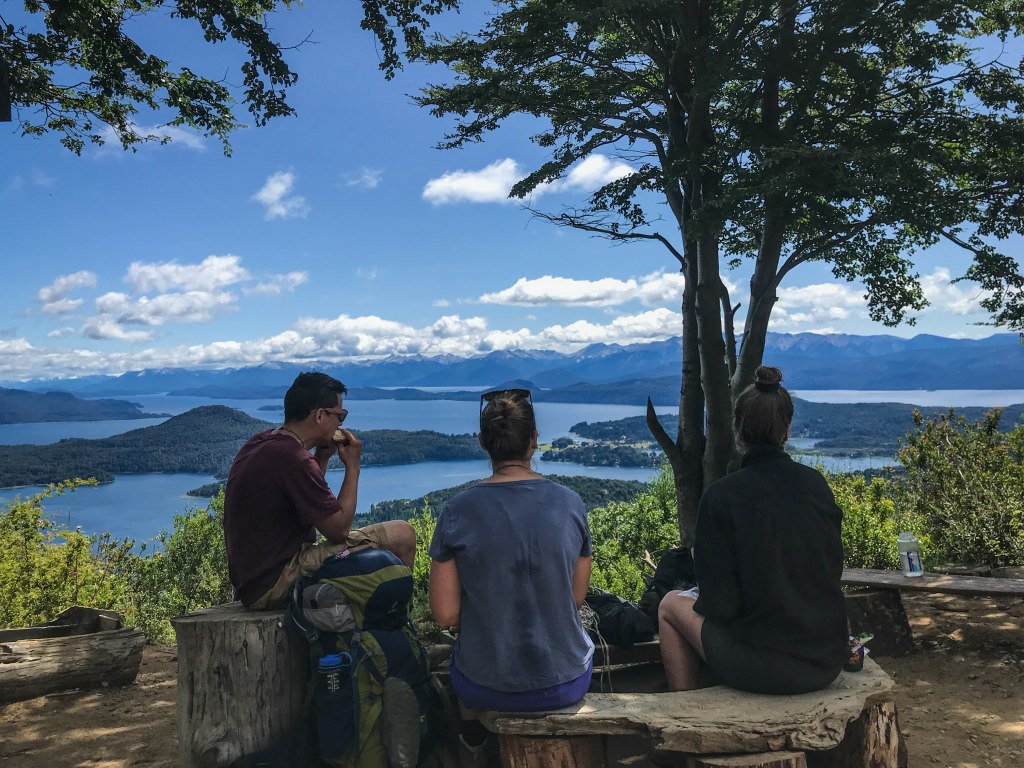
At the end of the hike we had covered 48.3 km (GPS tracked, Diana even 53 km). That doesn’t sound much when you consider that it was 5 days. But we also managed to overcome a height gain of 4.277 m and a height loss of 4.439 m. Therefore we need a few relaxed days after the hike, where we don’t have to carry our backpacks and after we have returned in a completely overcrowded bus, we move back to the campground in Los Coihues.

Colonia Suiza (01.02. – 08.02.20)
Together with Tom, the Australian, we decide to change the location. From Los Coihues we want to take the local bus, the Collectivo, to Colonia Suiza in order to camp there for the last days we will stay in Patagonia. The first bus is completely empty and we have no problem to store our backpacks.
But this is to change in the second bus. This one is so full that it doesn’t even stop at the bus stop anymore. The bad luck is that the next one doesn’t leave for 6 hours. Quickly draw a sign and put your thumb out of your hand and try hitchhiking.
After a few moments a woman calls us from the other side and asks where we want to go. Luckily she (and her husband) has the same destination as we do and a considerable tetris party starts to load three more people and their big backpacks into a small Opel. We make it and continue our move towards Colonia Suiza.
It is Wednesday and that means that there is a traditional speciality in Colonia Suiza – Curanto! Also known as Patagonian Pit Cooking to English speakers, it is a traditional way of preparing vegetables and meat underground, so that it is protected from the wind that is omnipresent in Patagonia. So, after setting up our tents – by the way, our 100th night in a tent on the trip – we go to the local market, buy a ticket for our share of the Curanto and then watch how the food is dug up.
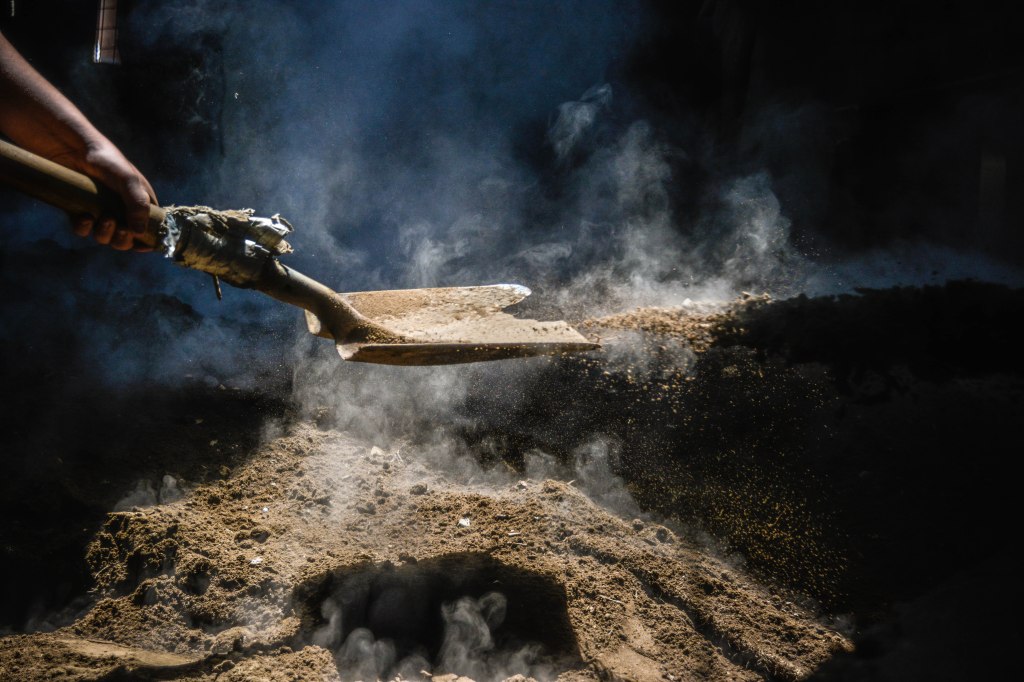
Underneath, blankets for insulation and a layer of branches with leaves come to light before they are removed to reveal the food.
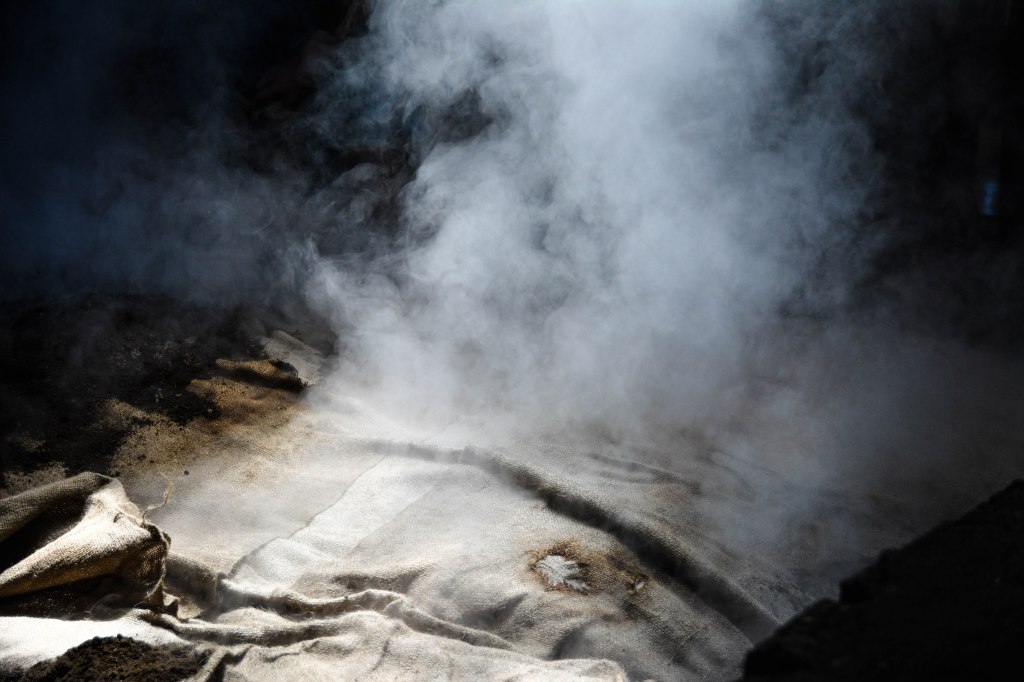

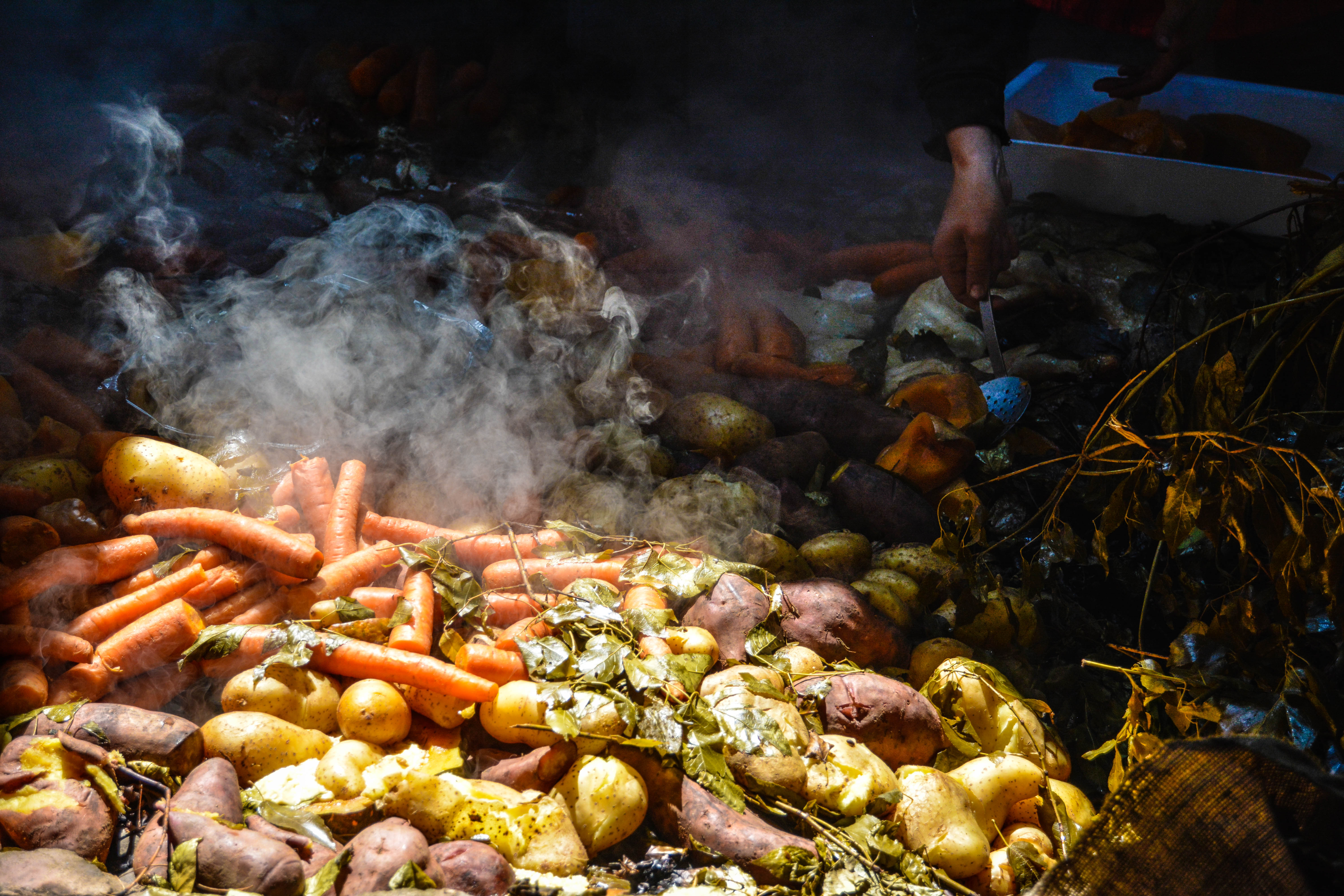
We are by far not the only ones present. The spectacle is accompanied by many spectators. Many Argentineans who are on holiday in Bariloche take the chance to go to Colonia Suiza and also eat Curanto.
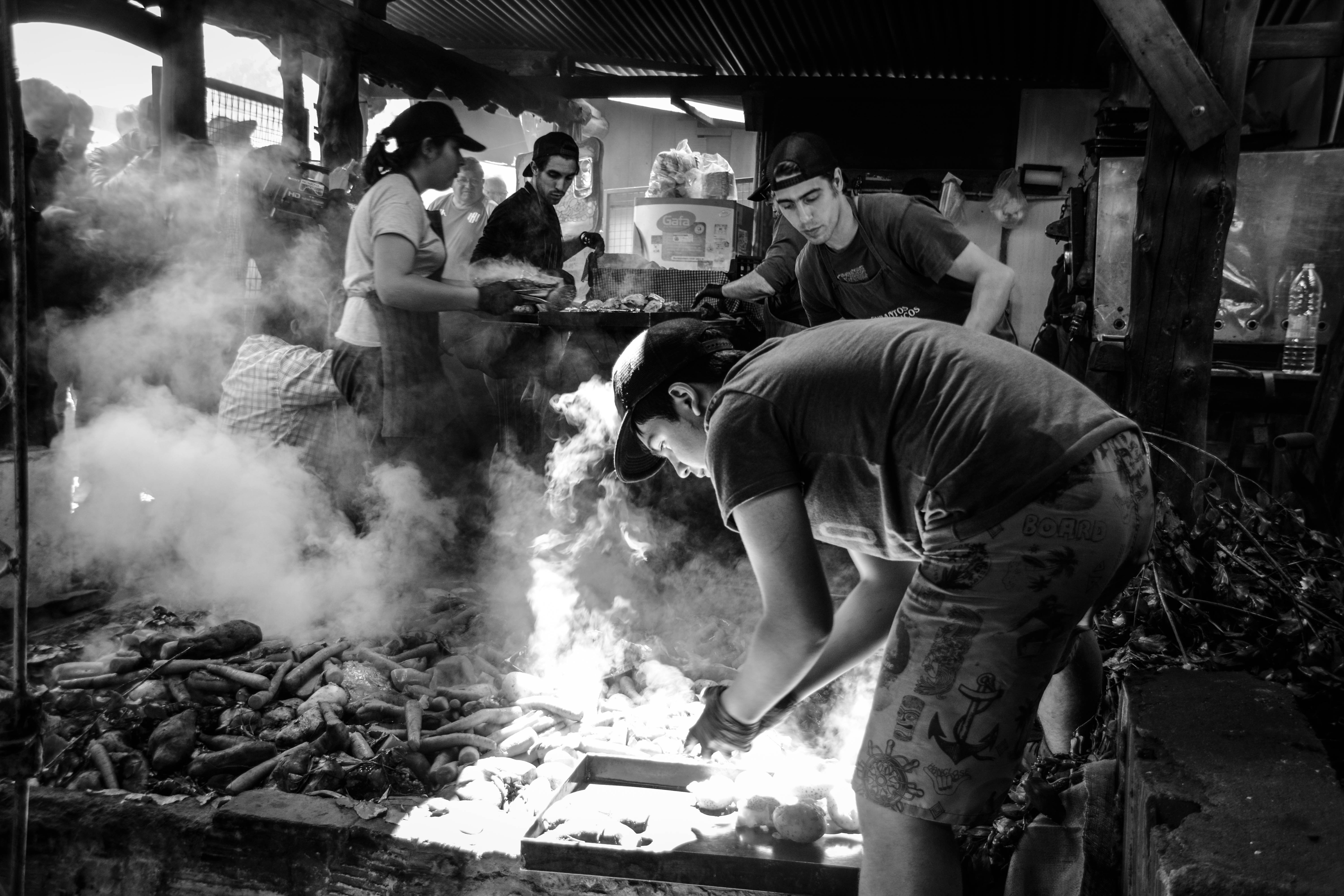
With a full stomach we start the relaxation on this day and decide to hike to Laguna Negra the next day. Diana had not seen it on the last hike and we want to make up for that.
Nevertheless, it is a long day hike and so we start early at 7 am – Colonia Suiza is still in the shadow of the adjacent mountains and there is no longer any trace of the hustle and bustle of the lecture. The first part of the hike is a relaxed walk through the forest, along a river and with an even gradient. On the steep ascent to Laguna Negra we take a short detour to an ice chapel.

Shortly afterwards we reach Laguna Negra and the bright red Refugio Manfredo Segre.
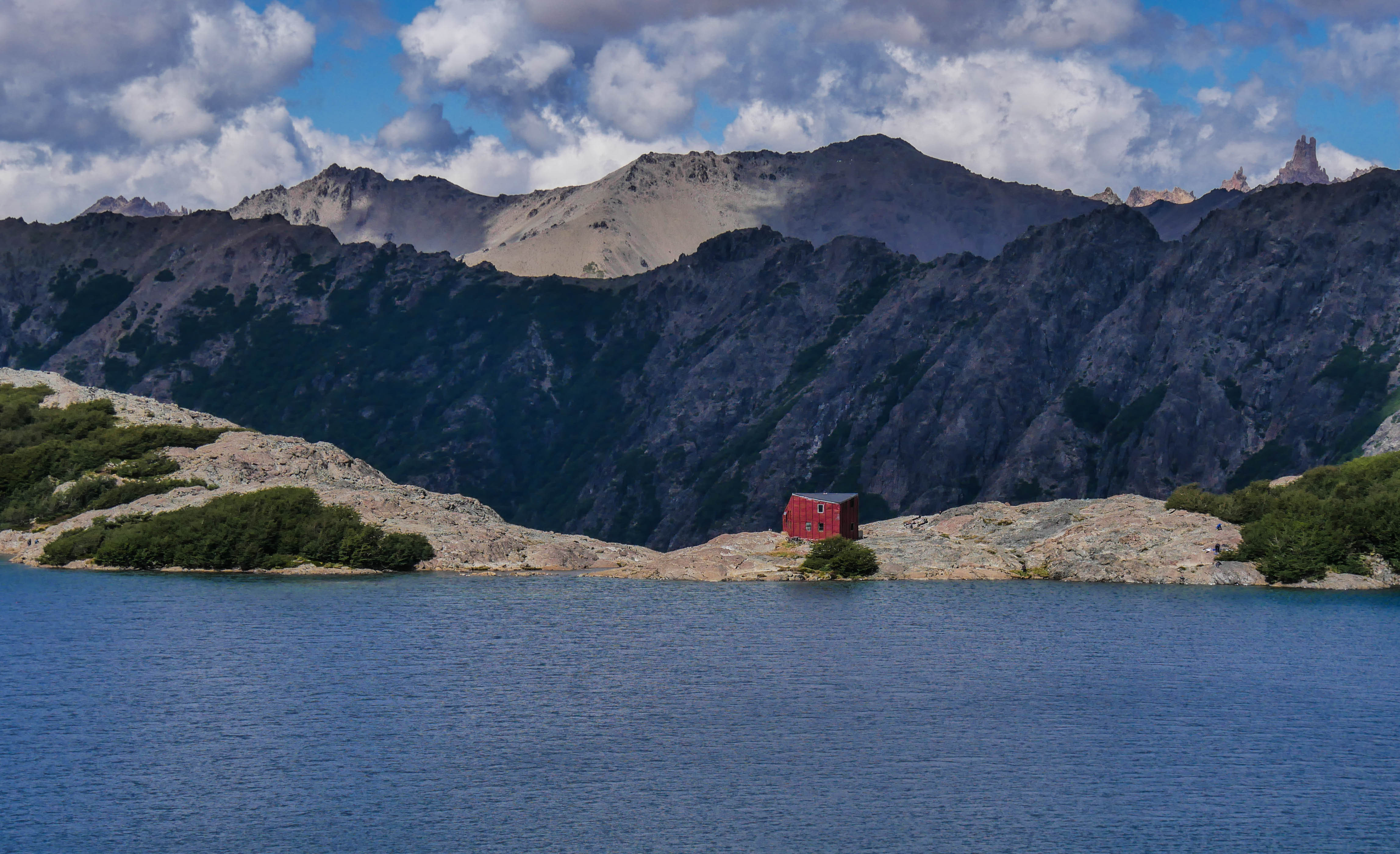
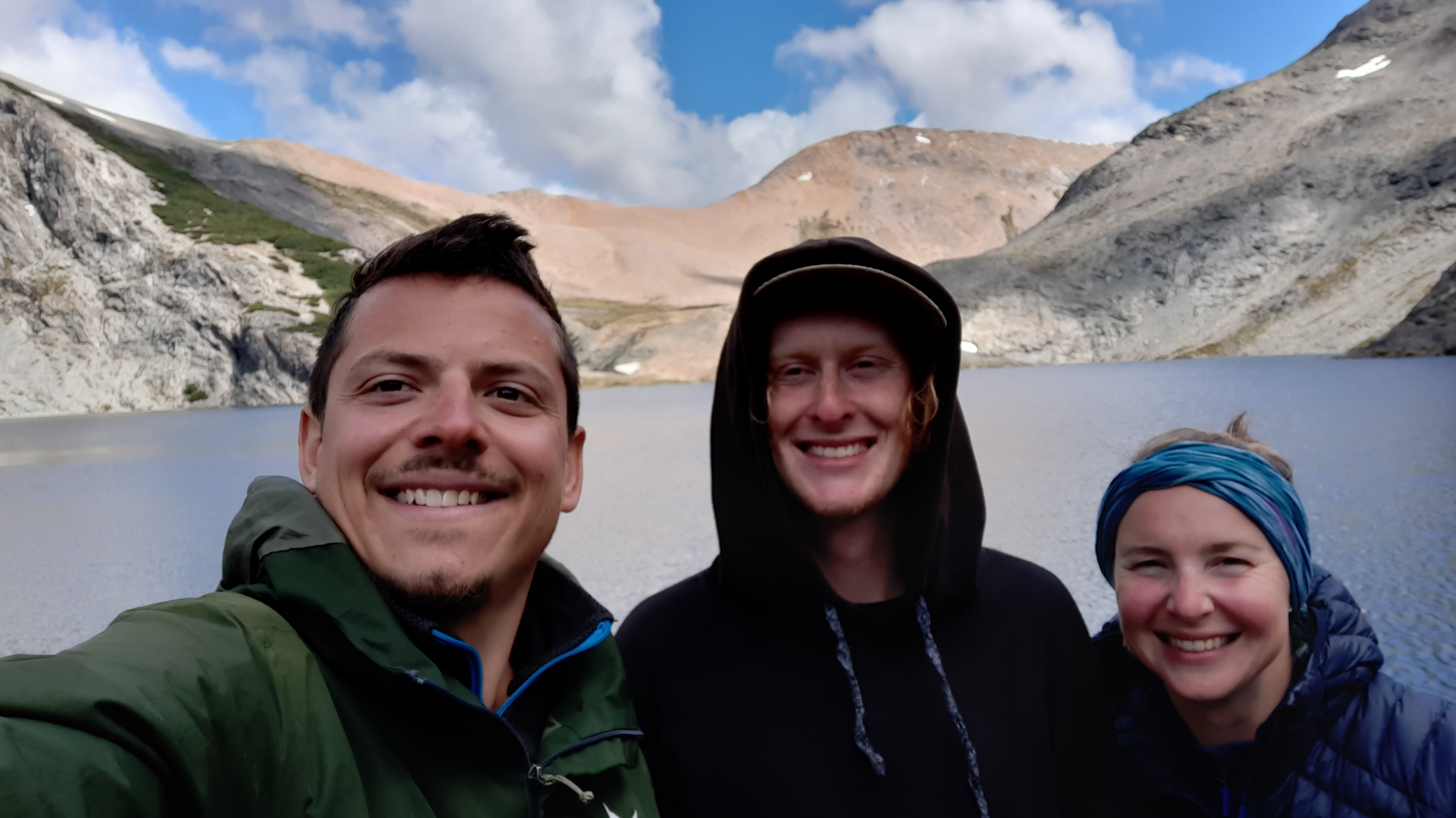
We take a break and then decide to climb the pass behind the lagoon. The view was definitely worth it:
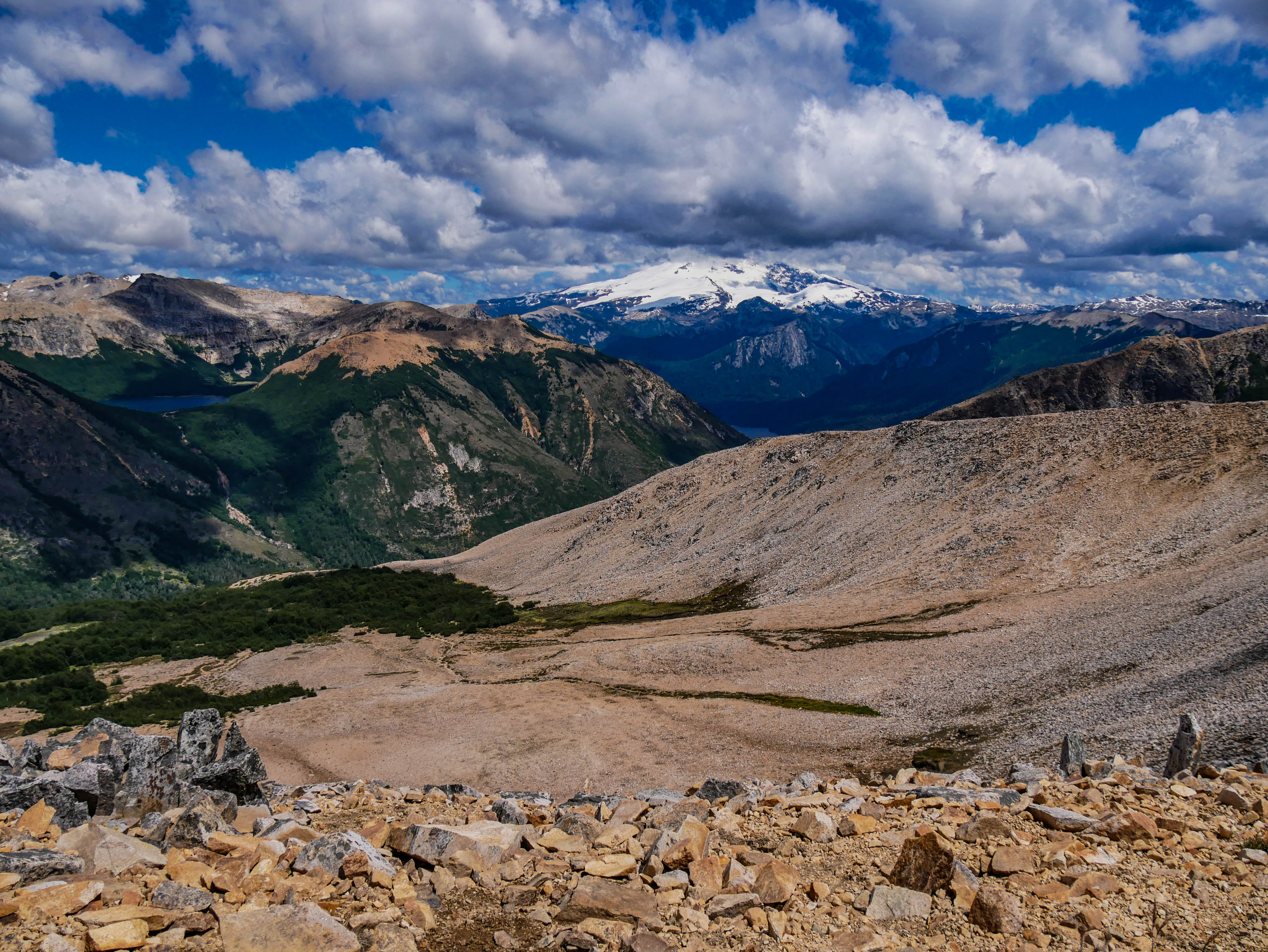
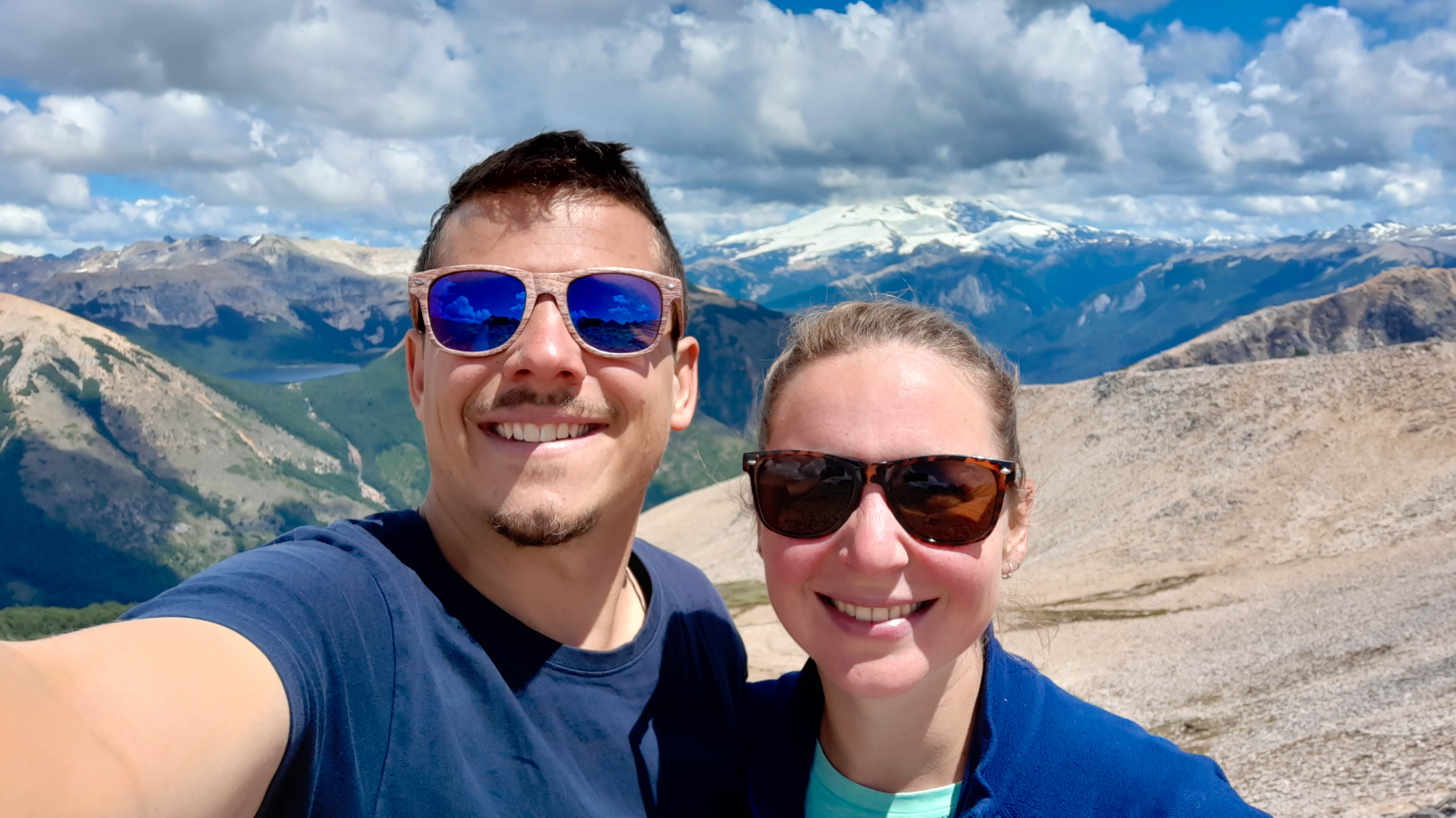
The way back is the exact same as the way there. After 26 kilometers and over 1,000 meters of altitude gain we are exhausted in the evening. Nevertheless we find a small brewery on the way back and after a pit stop we go back to the tent.
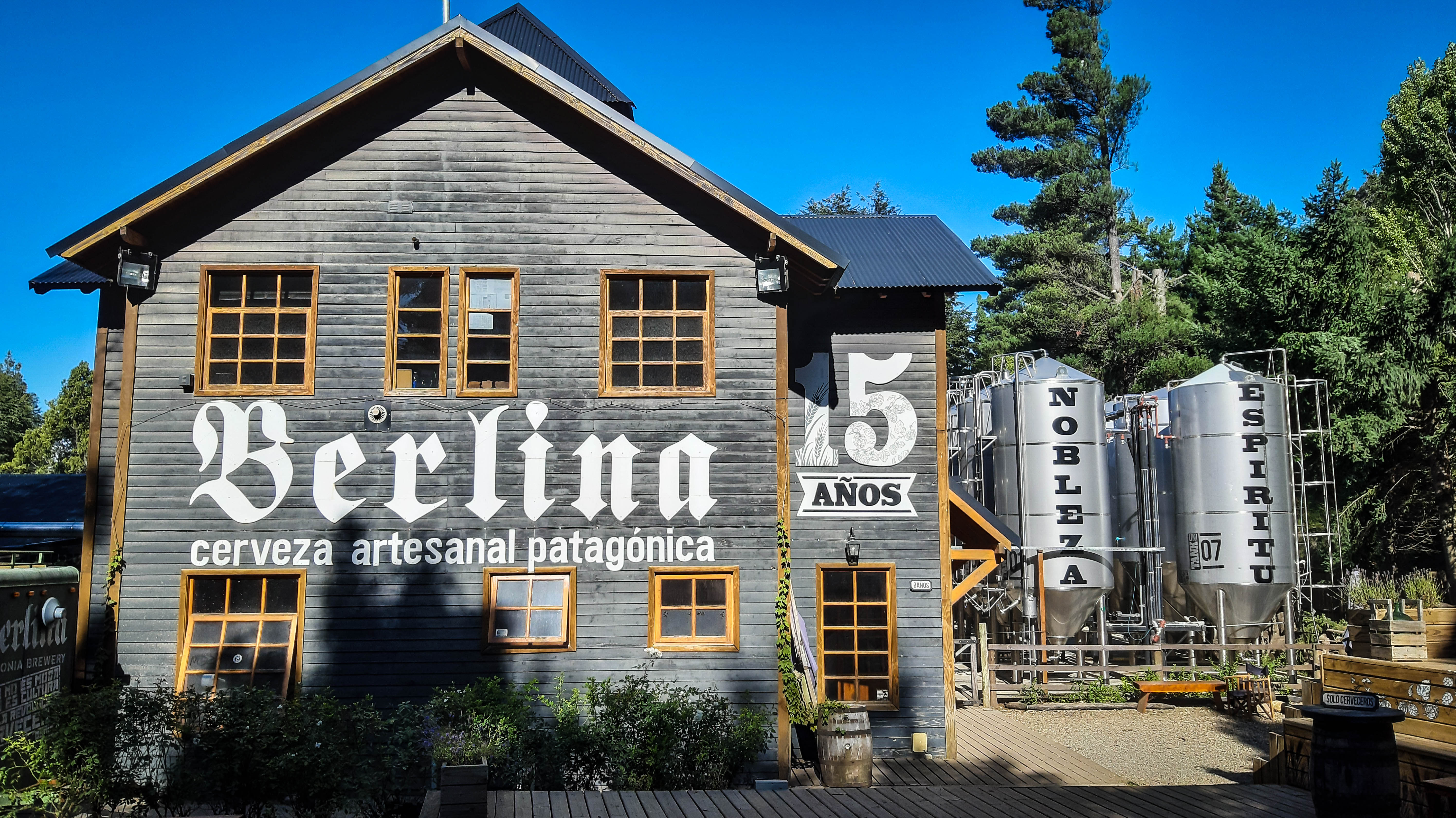
At the campground we realize with surprise that Marcel and Anne followed us and also arrived in Colonia Suiza.
On our last full day in Patagonia, we are drawn to a famous brewery not far from Colonia Suiza. We cover the way on foot, hitchhiking and with a short swim break.
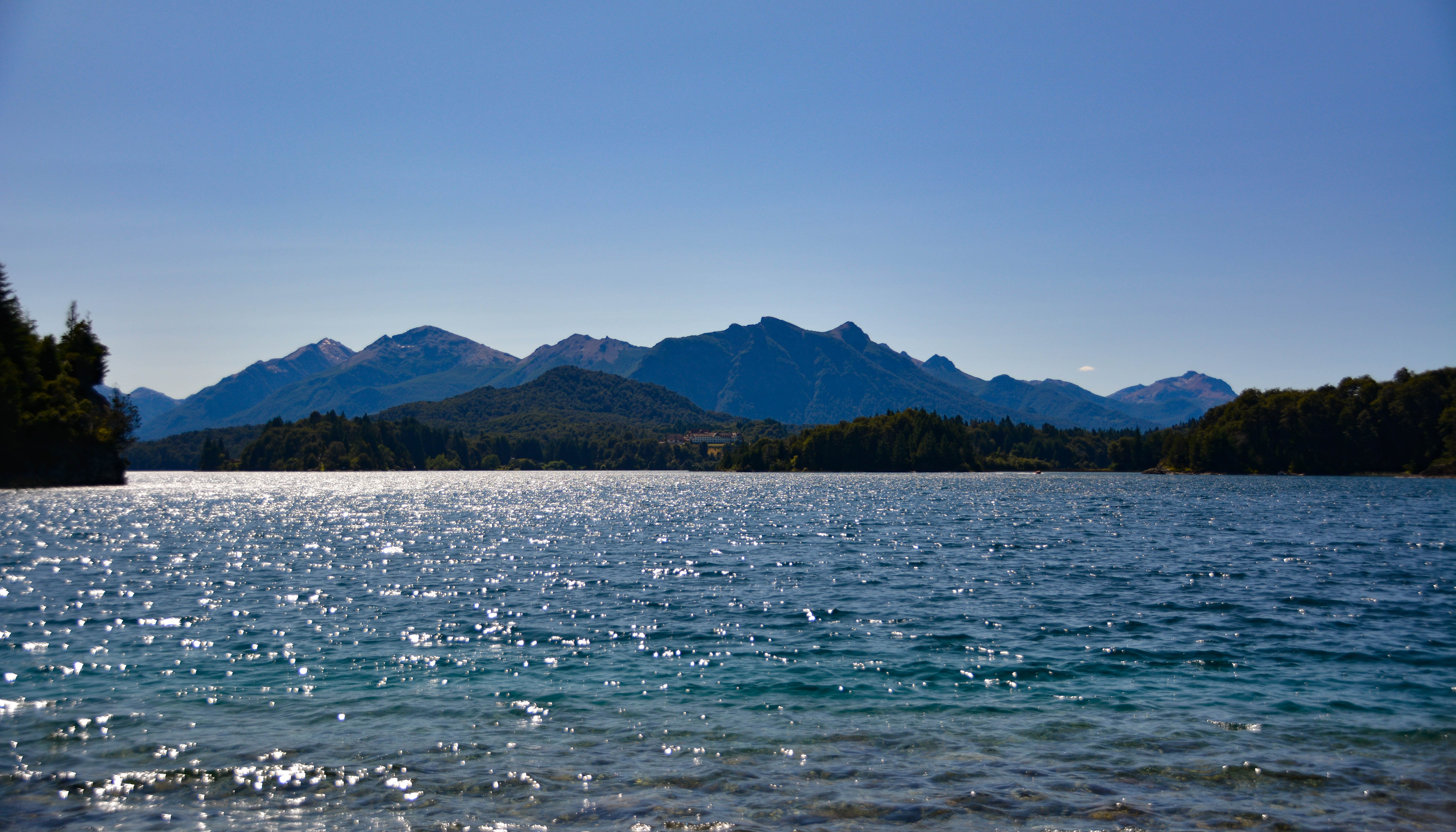
A little later we arrive at a magnificent viewpoint:


A short walk later, we finally arrive at our destination: the Cervezeria Patagonia!
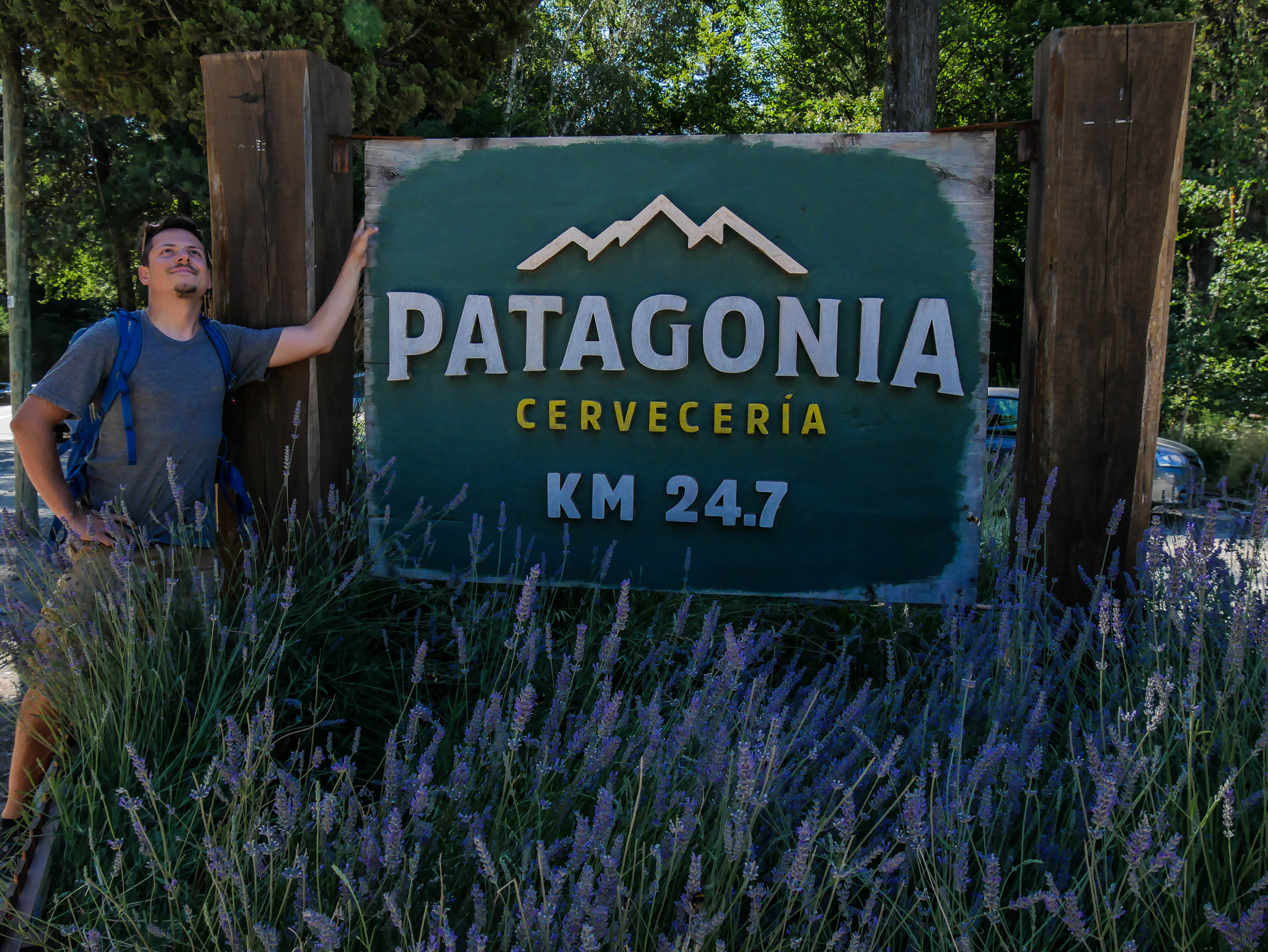
We have already drunk the beer several times during our trip to Argentina and found it drinkable. The area is fantastically situated at the Lago Nahuel Huapi and while we drink beer from biodegradable eco-plastic cups (still wondering why they didn’t hand out glasses), we enjoy the great view which becomes, nevertheless, in inexplicable manner in the course of the evening more and more blurred!

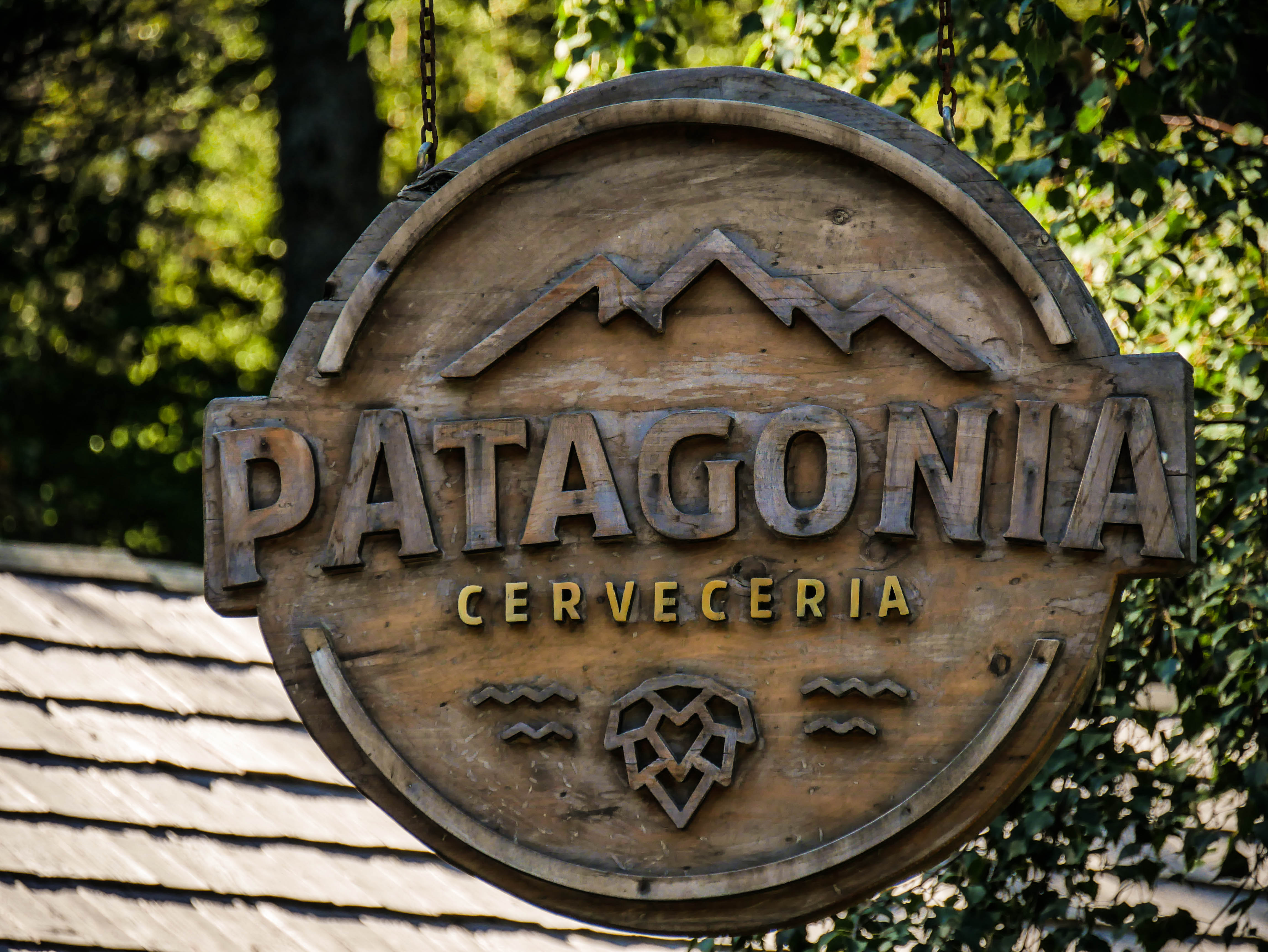
On the way back, the hitchhiking works great and we ride along on the loading areas of pick-ups twice. Once again we can enjoy the mountains in front of the purple sky.
The next day we take down our tent for the last time in Patagonia. This is the moment when we realize that we will leave Patagonia today after more than three months. There is a sad and queasy feeling, but we have booked a bus to Buenos Aires, the Argentine capital. After the bus leaves and circles the east side of Lago Nahuel Huapi, the view is perfect and we can say goodbye to the Patagonian mountains behind Bariloche.

Slowly it gets dark outside and we get closer to the Río Negro, which marks the border of Patagonia. It is very quiet in the bus. No cell phone noise and nobody is talking. Those who are not sleeping stare spellbound at the sunset. Our last sunset we will see in Patagonia.


The farewell is hard for us and we are also very calm on the trip. When we wake up, the world will look very different.
Buenos Aires (09.02. – 19.02.20)
When we wake up again on our bus ride from Bariloche, it looks completely different outside: It is flat, no mountains in sight and the landscape is dominated by agriculture. Every now and then we pass a pick-up truck on whose loading area two or three people share mate. As we slowly drive into the urban area of Buenos Aires, we realize that we haven’t been in a big city for more than three months – there are skyscrapers everywhere, there are narrow street canyons, thousands of cars and it is loud. The bus station in Retiro is not very nice but we only have to walk to the metro to get to our couchsurfing host Julian.
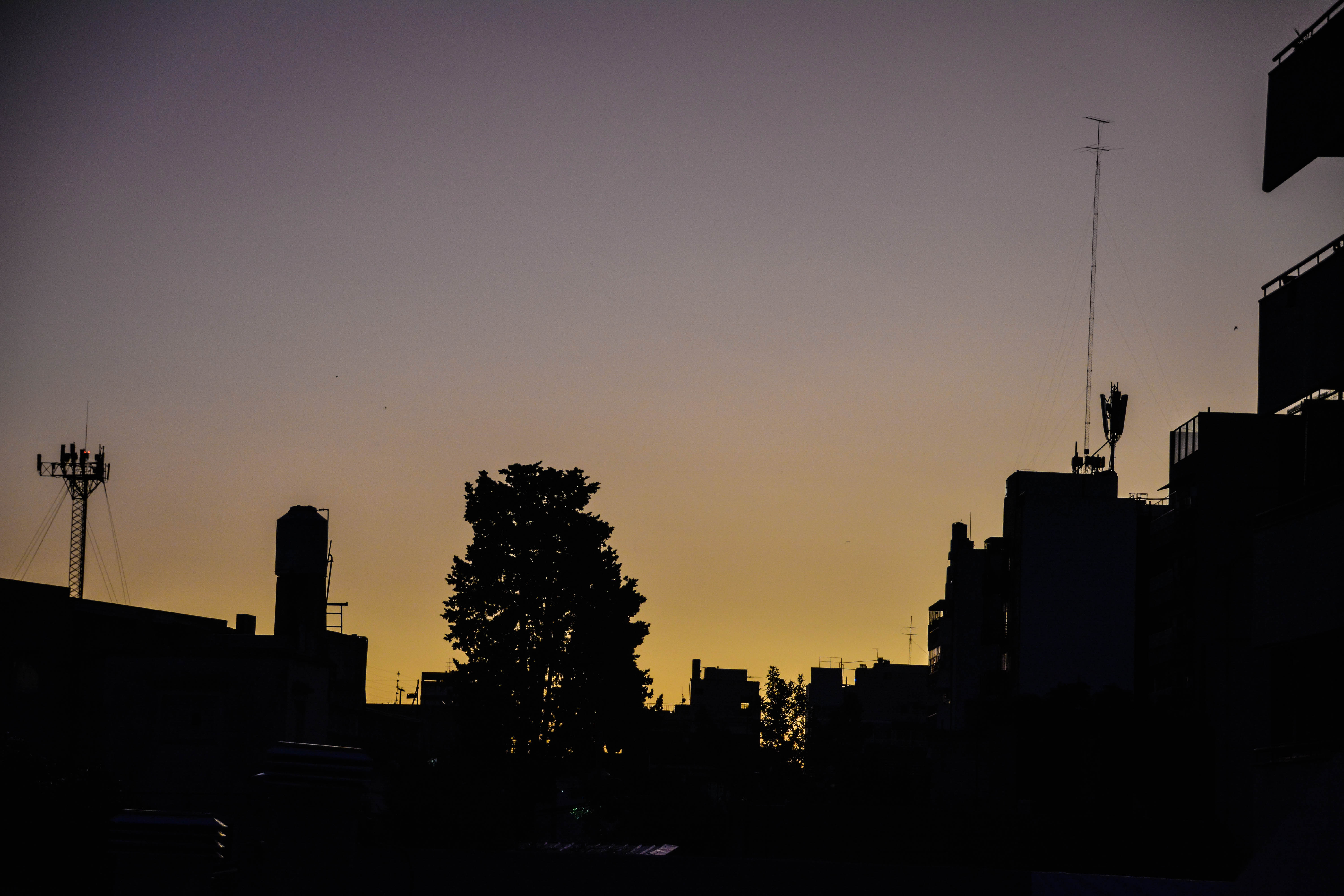
Together with Julian we have a good time. Of course we cook Käsespätzle together one evening and exchange ideas about travelling, Buenos Aires and other places in Argentina and Julian’s plans to come to Germany for a year.
The time in Buenos Aires we spend exploring the different quarters of the city. This is the first time we are warned how to move around the city. Since armed robberies (also with deaths) are common in the city, we of course follow the warnings. One quarter, where you should stay only in the tourist part and not in the side streets, is La Boca. Since we are only supposed to stay in one street of the quarter, we take the bus.

La Boca, with the famous pedestrian zone Caminito, is considered the birthplace of the Tango and is one of the oldest quarters of the city. The first immigrants built brightly coloured houses there, which today are famous postcard motifs for the city. But we are told several times that we have to stay in the pedestrian zone and so we walk with many other tourists through the two safe streets. We meet Seb again, whom we had already seen in Puerto Varas and Bariloche.

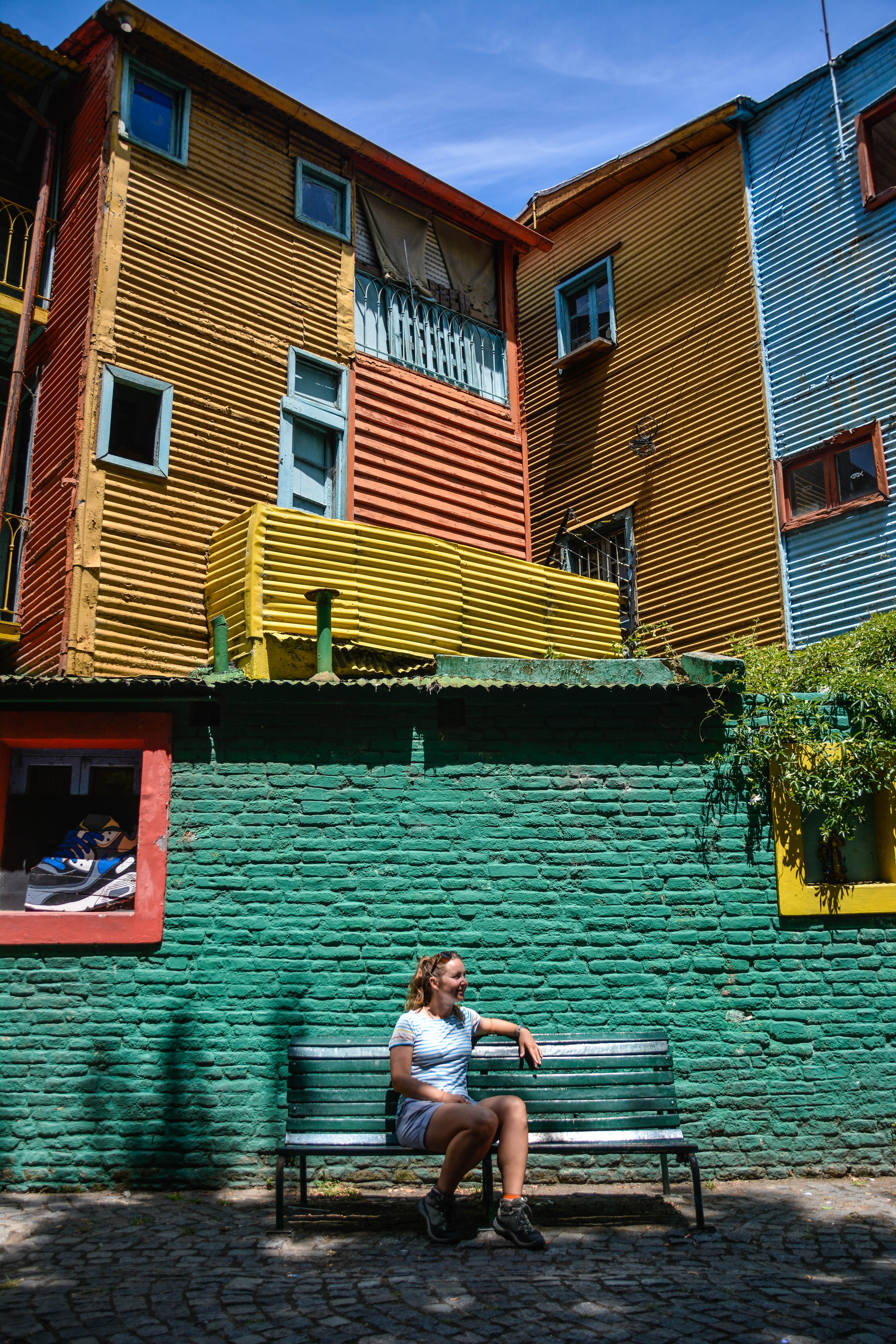
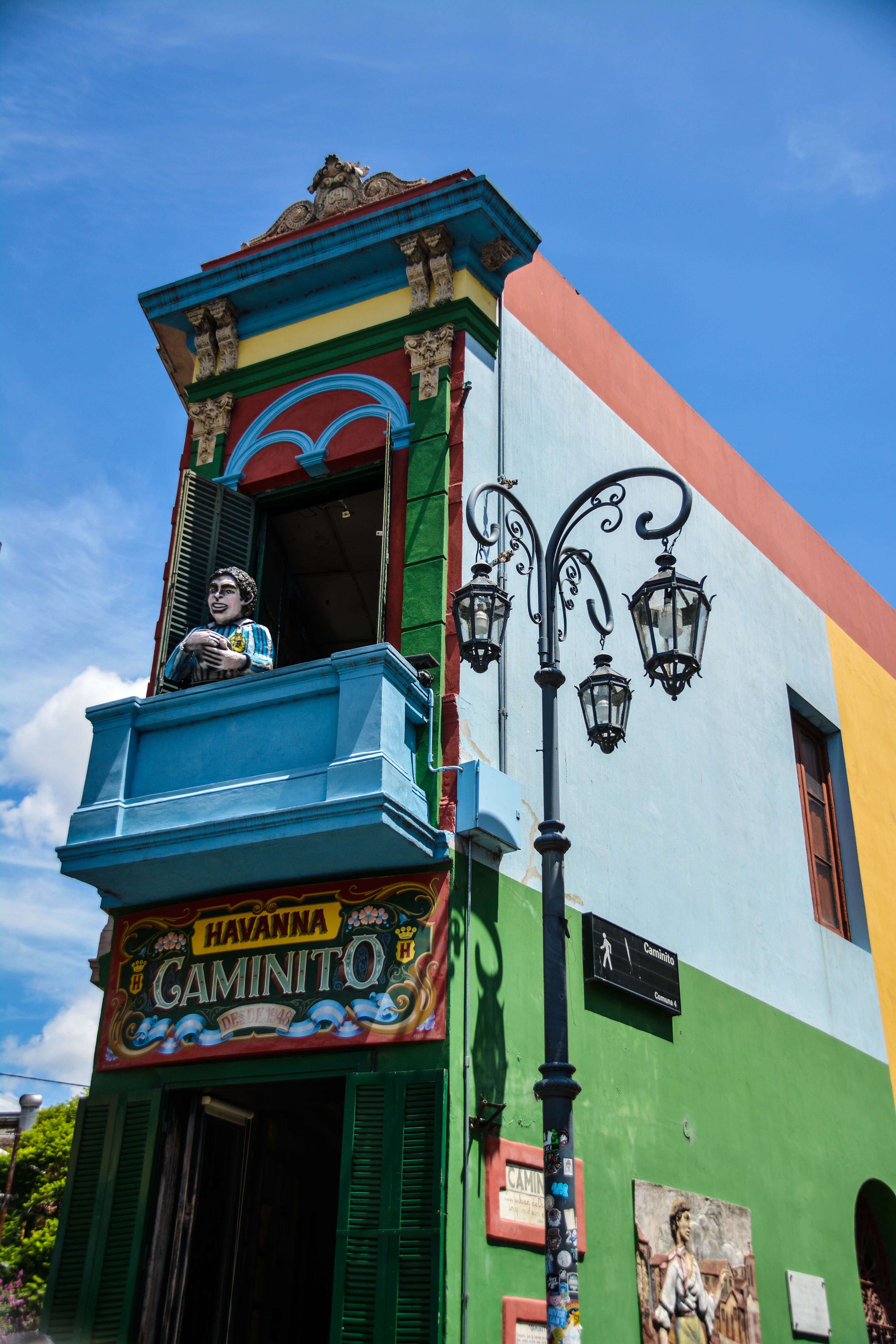
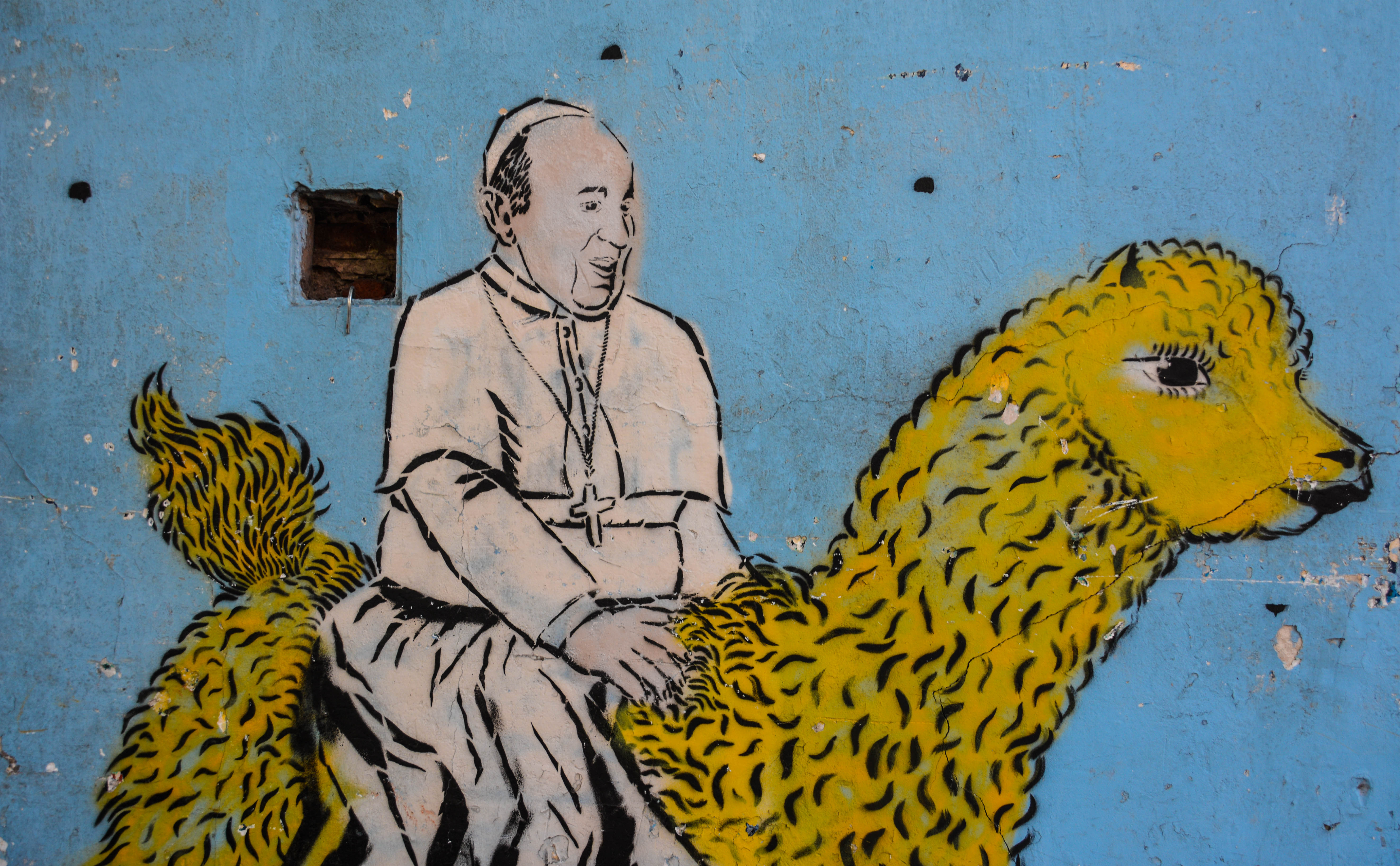


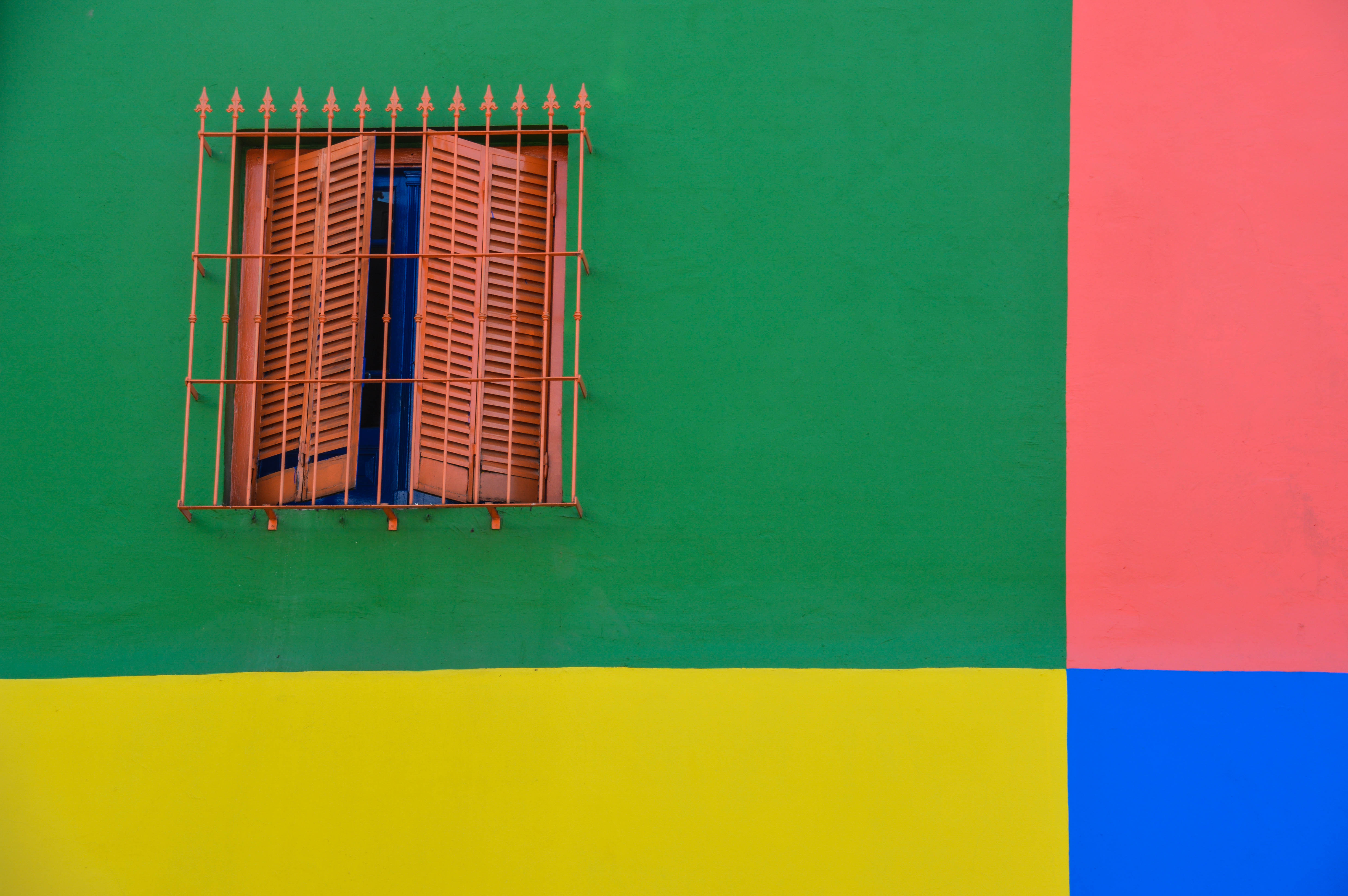
Another district that is only suitable for strolling during the day is called San Telmo and houses an old market hall.
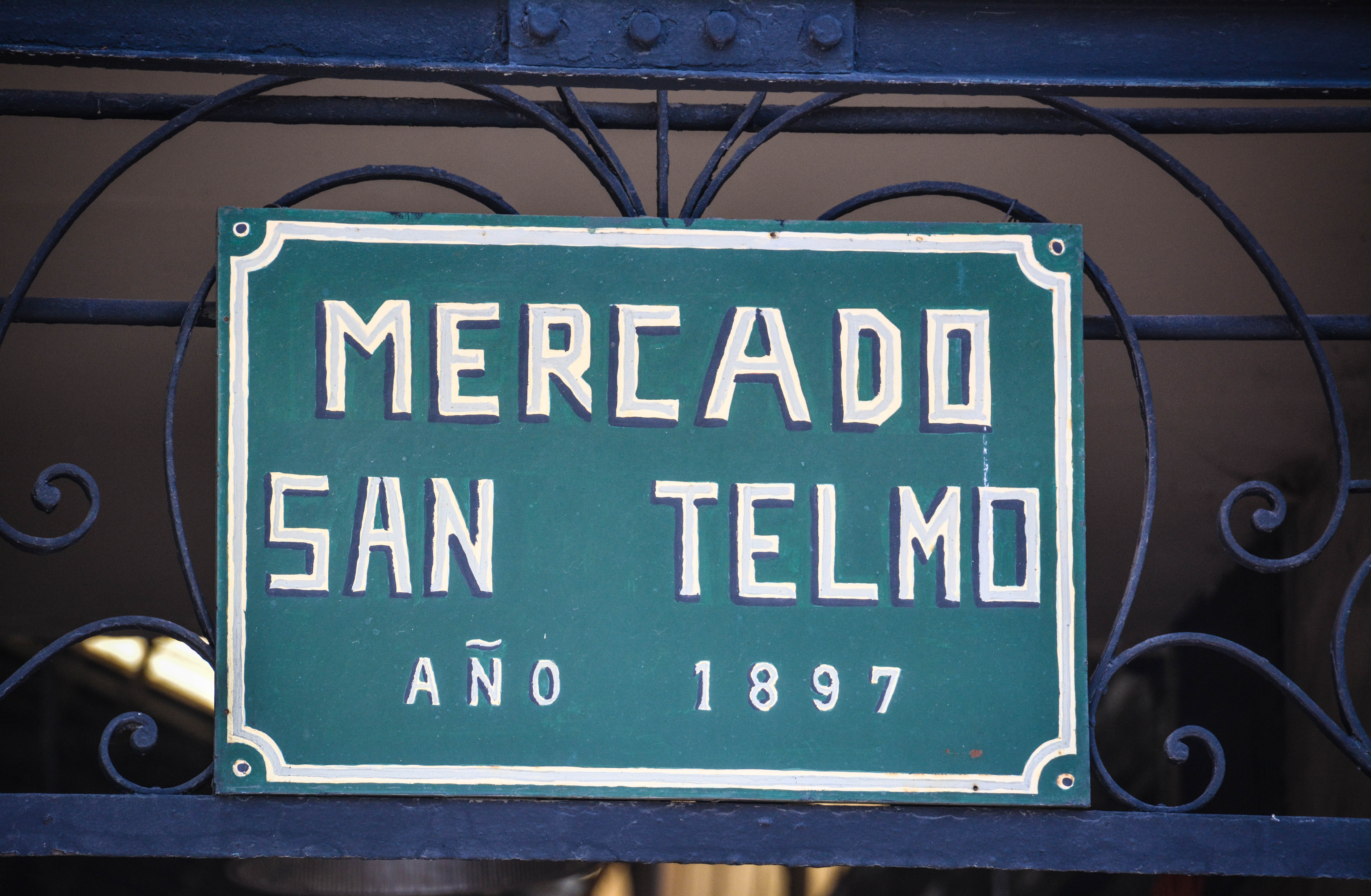
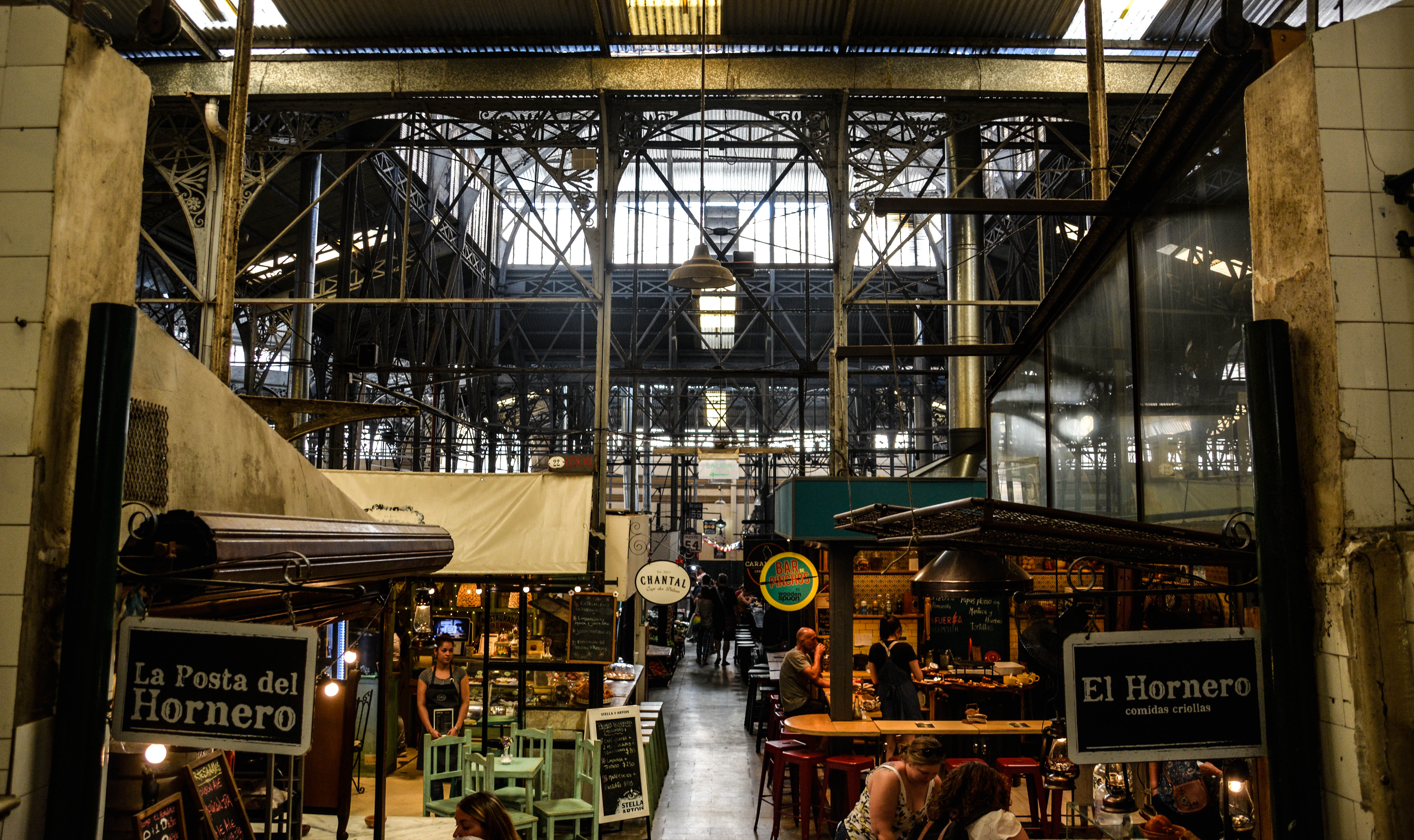
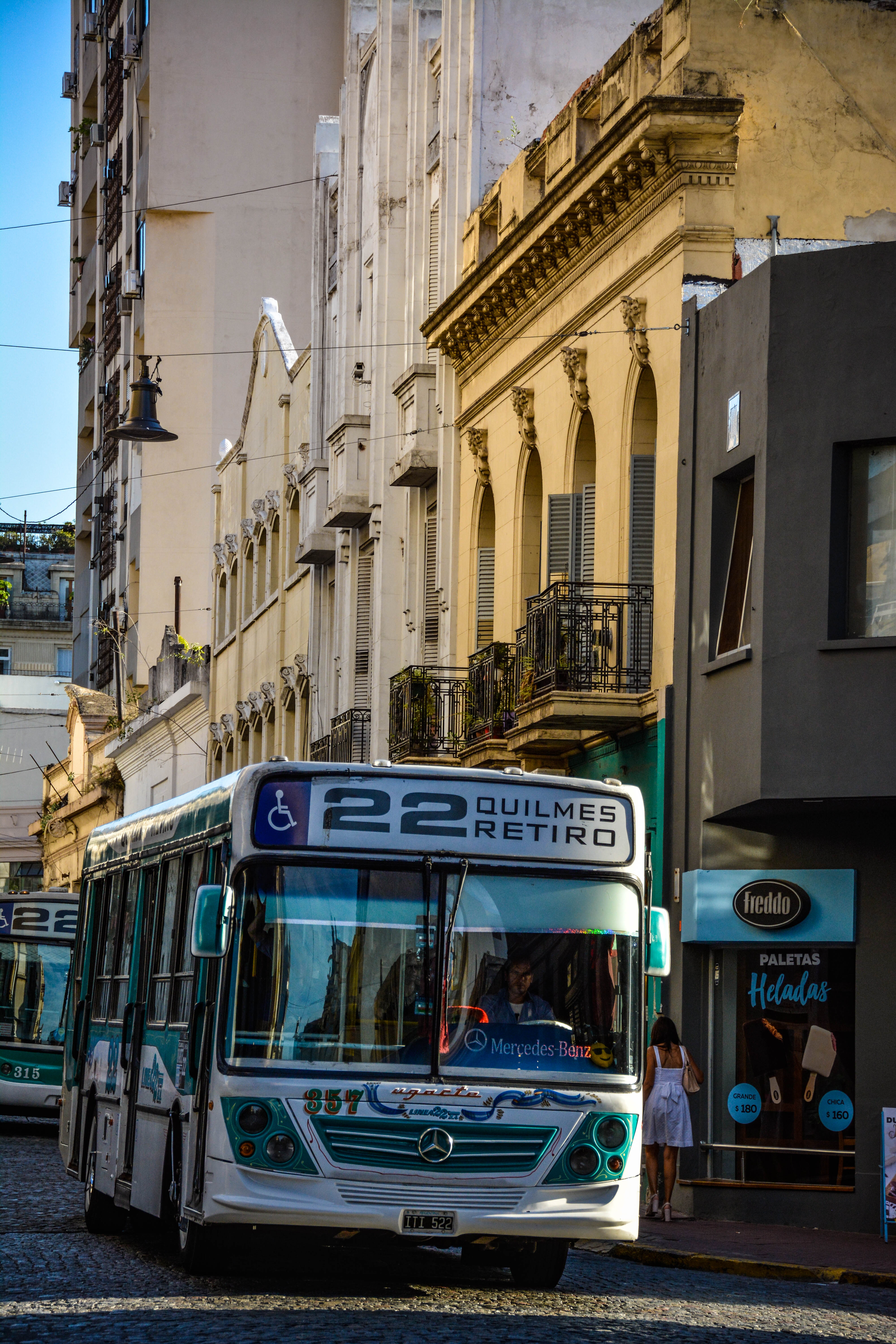
The new and somewhat more prosperous part of the city is located around the Puerto Madero port area. There are some expensive bars there and there are still old sailing ships in the harbour.
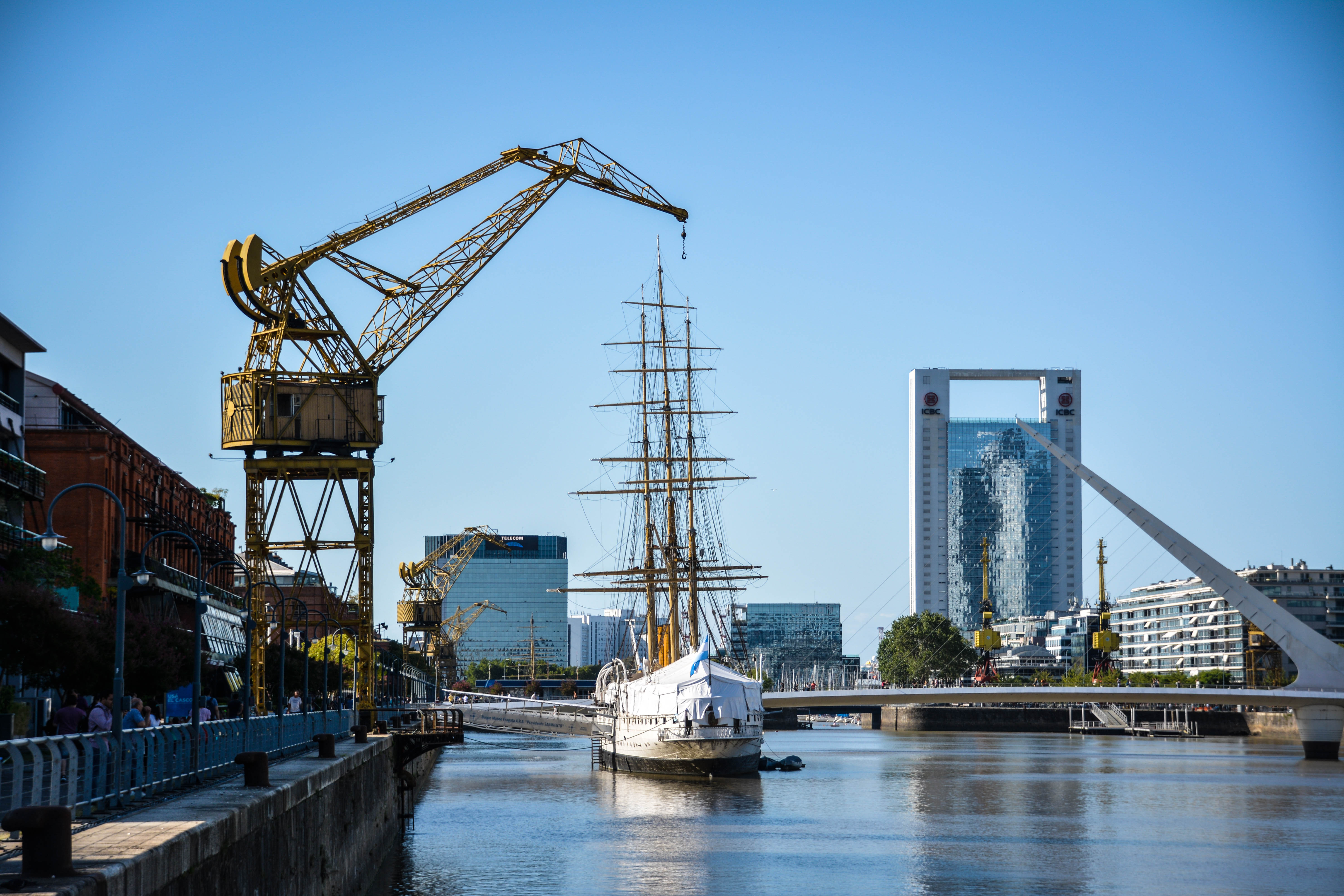
A quarter that one can enter in the evening as a person from outside of Argentina is Palermo. There are a lot of bars and the atmosphere is exuberant. One evening we meet Julian at a burger shop, which apparently was ranked 14th best burger in the world.
Through Couchsurfing we also find the possibility to learn some basics of Tango. We expect an event that is made for tourists, but are positively surprised by the opposite. The dance school is located in a quiet residential area and the dance teacher only speaks Spanish. After about 2.5 hours we master the basic step and a figure.
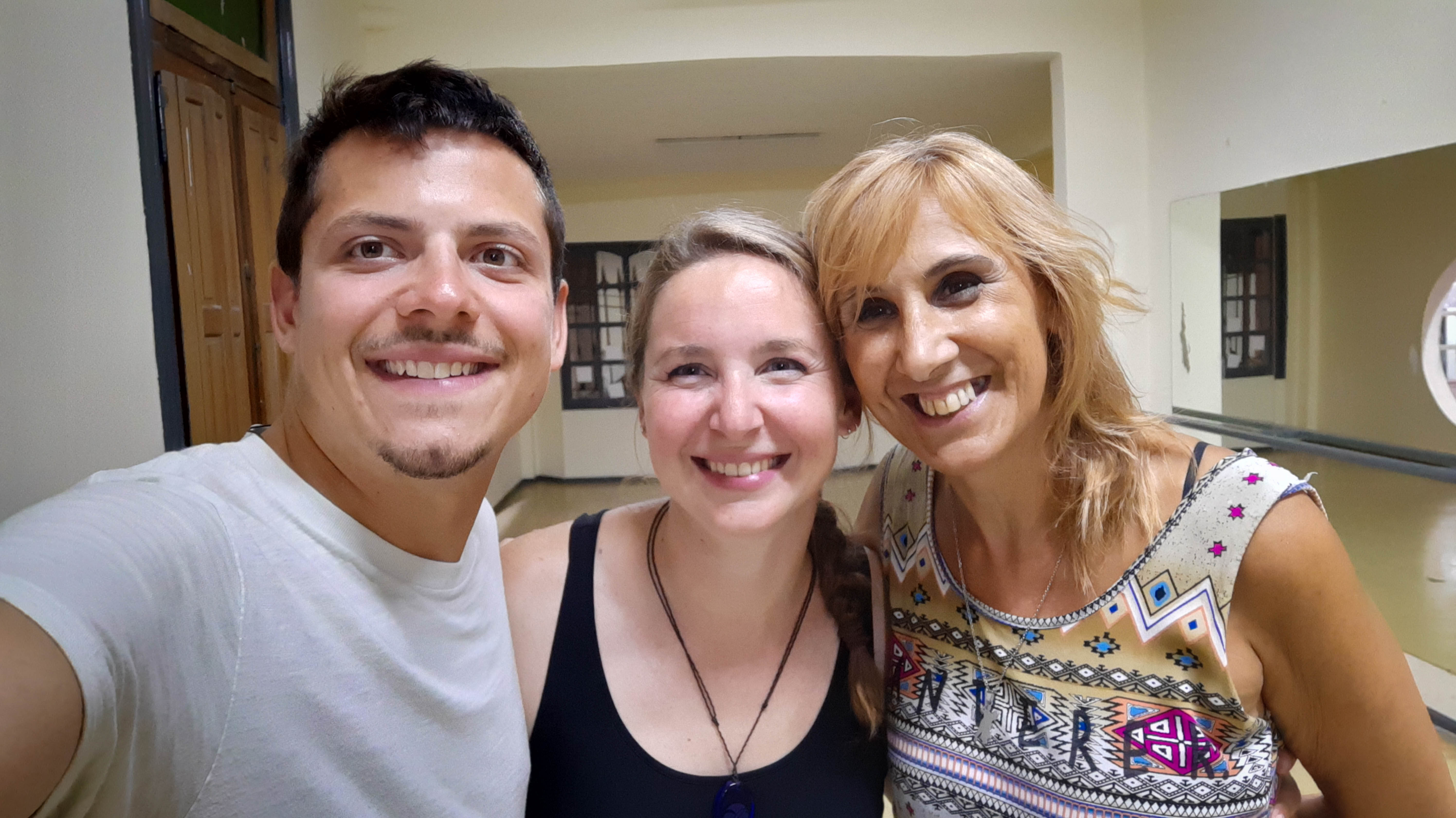
We also spotted a blue Tango tag at someplace, which is worth mentioning.
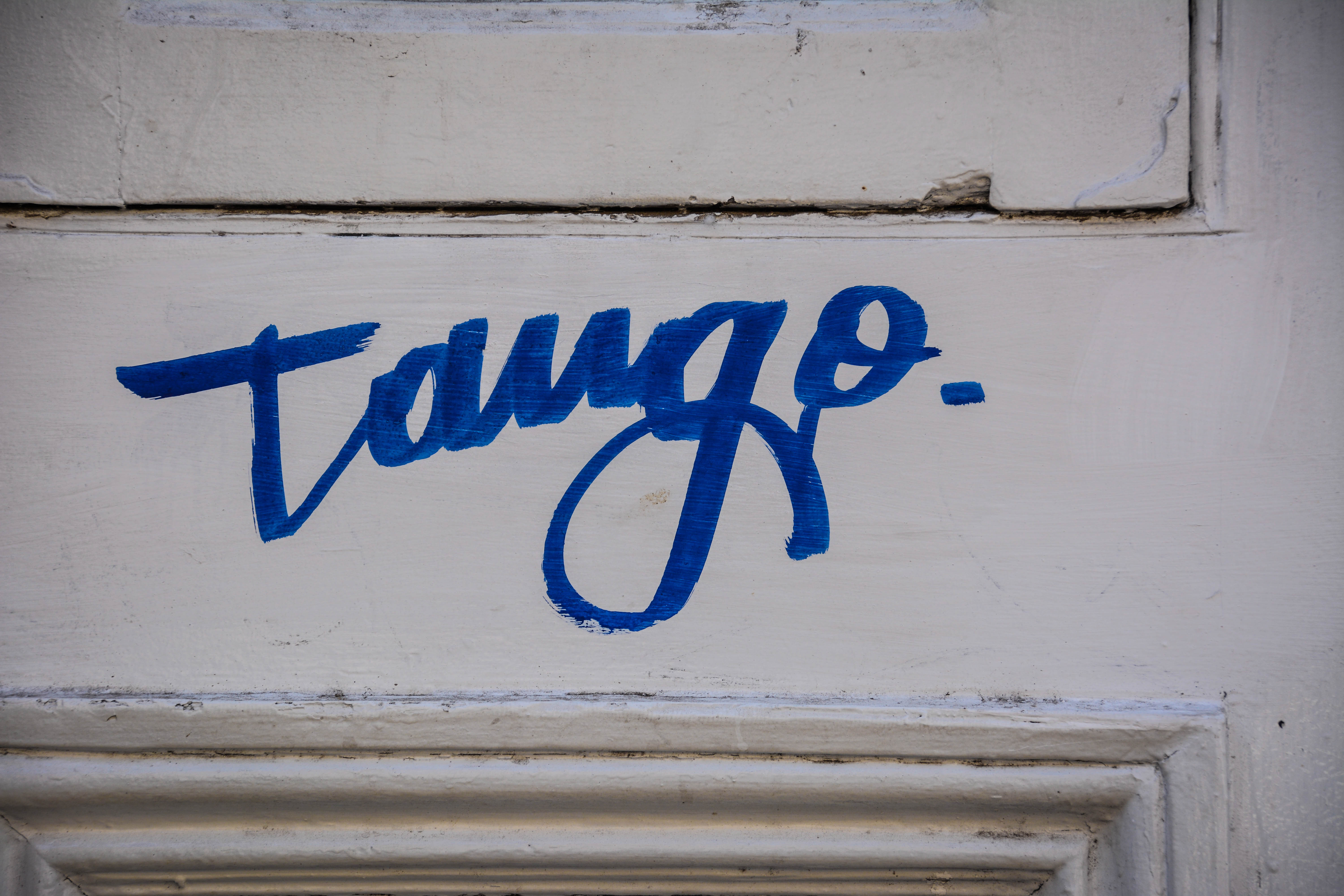
In Bariloche Lucas and Tom had met Esteban, who also lives in Buenos Aires, on the last evening. So we ask him if he would like to meet and we see him at the cemetery Recoleta. Many famous Argentines are buried there – for example Eva Peron. The wife of President Peron was very popular with the people and did a lot for equal rights, equal opportunities and women’s rights. Esteban tells us that his grandmother received a sewing machine as a gift from Evita (as Eva Peron was called by the people) to open her own business. Even today many people still lay fresh flowers on the family grave.

The cemetery is also suitable for tutoring in Argentine history and Esteban knows an incredible amount. But there are also strange stories at the cemetery. A man was buried in a coffin with springs because he was afraid of being buried alive. Until today, however, he has remained lying there – so the fear was unfounded.
Esteban is a friend of Argentinean cuisine and we meet again in the evening at the best pizza shop in town – Pin Pun! Once a year the Muzza5k takes place in Buenos Aires: a 5 km long race in which about 400 participants stop at 8 pizza shops along the Avenida Corrientes and eat a slice of Pizza Margeritha (sp. Muzza). In recent years Pin Pun has always been awarded as the best shop. We unsuspectingly order a Muzza500 and are still surprised about the number and think that a pizza probably weighs 500g. But when the pizza is in front of us we realize that we probably have breakfast, because the 500 stands for the weight of the cheese – 500g cheese!
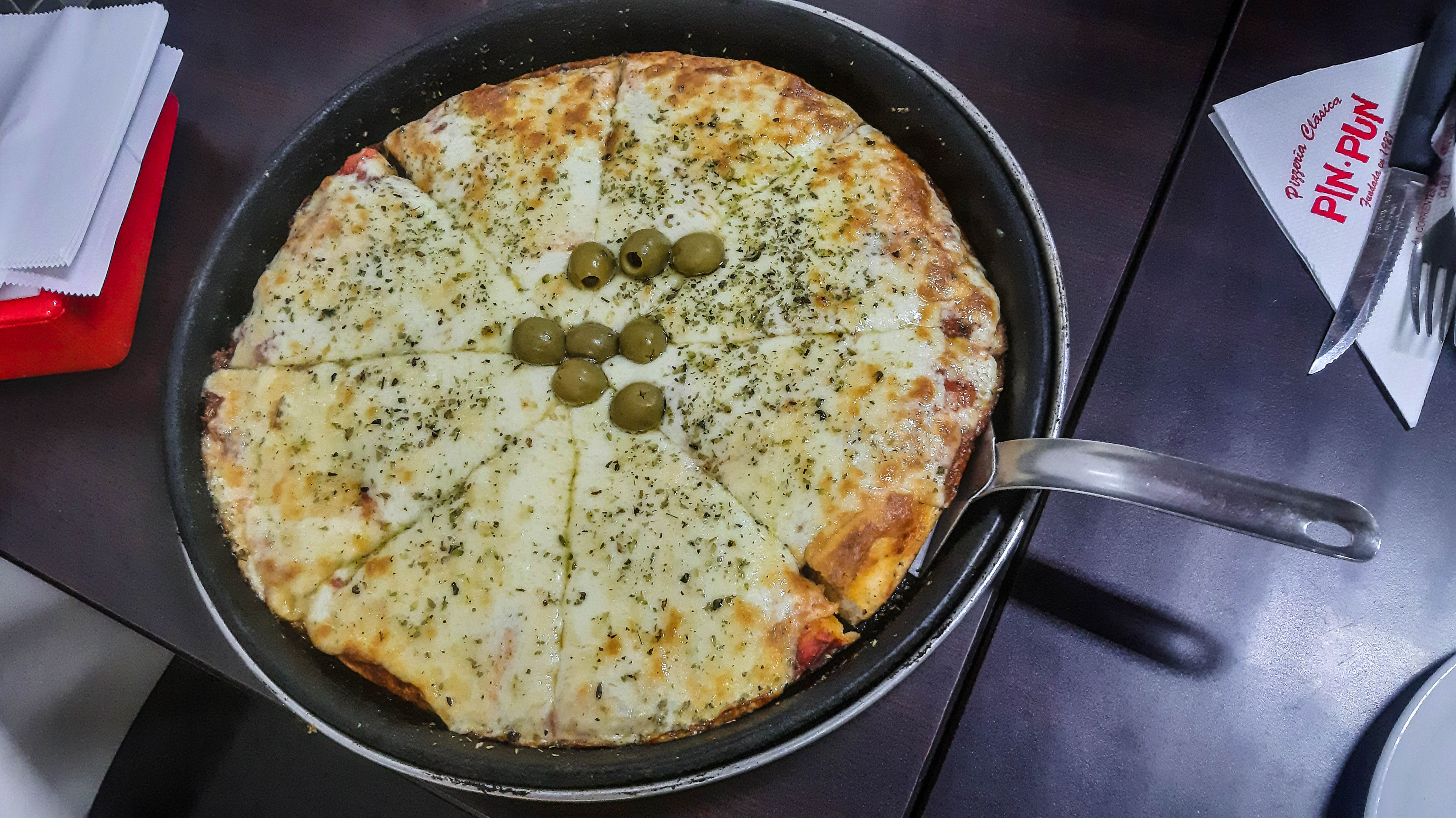
Since we could not see Guanacos (the Patagonian lamas) from close up, we go to the Eco-Park on the last day we have. This is the remains of a zoo, which is being closed step by step and is very popular with the local population. There, maras are running around freely and we can finally get a close look at guanacos.

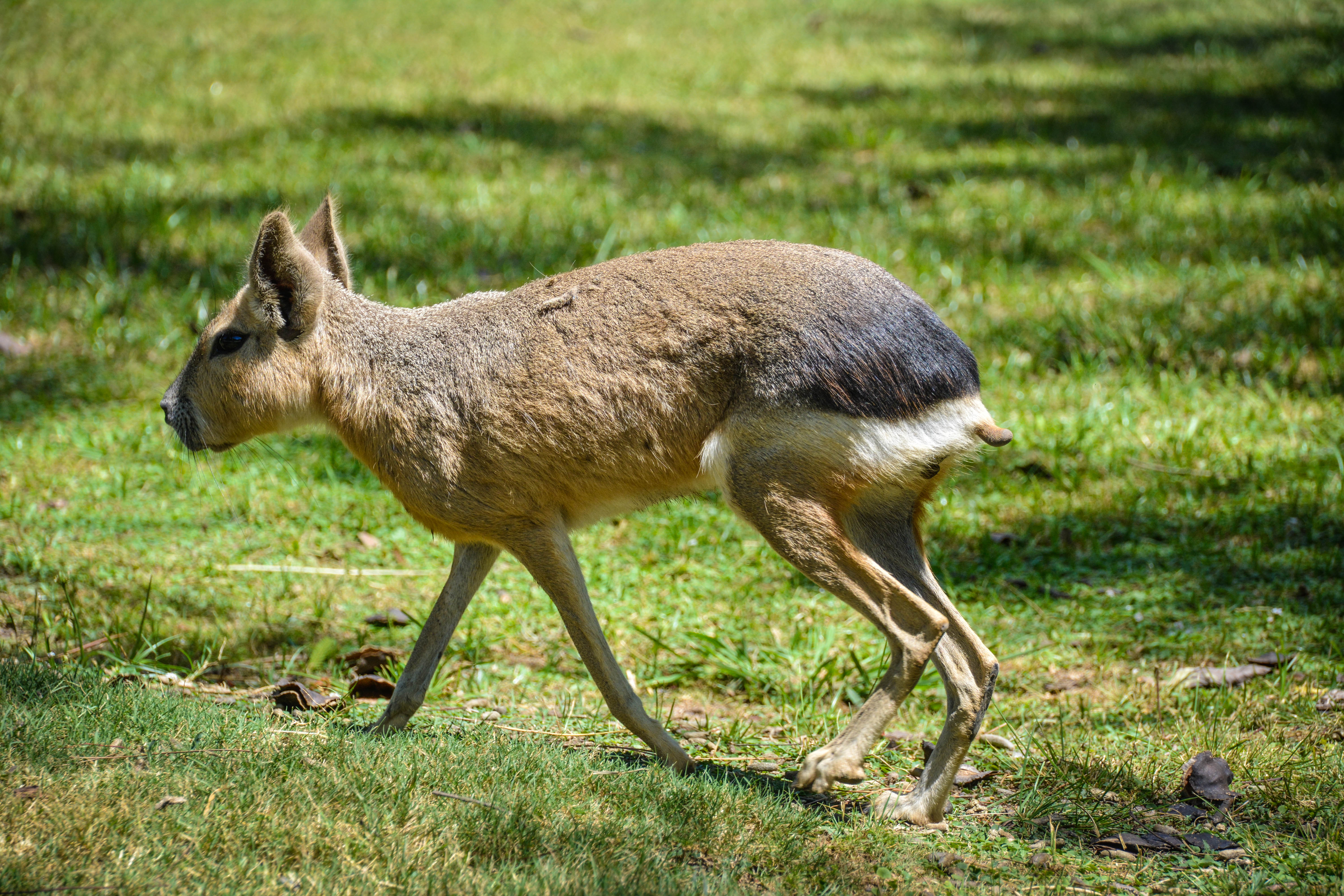
Later in the day we take the ferry across the Rio de la Plata to Uruguay.

Quebrada de Humahuaca and Iruya (20.02. – 04.03.2020)
From Buenos Aires we travel a long way north by bus. At the gate we are warned that the bus trip will take 3 hours longer. It has rained a lot and a bridge has collapsed so that we have to take a big detour to Salta. So instead of 23 hours we will spend the next 26 hours in the bus. But seen from this point of view the bus arrives very punctually. So our first stop in northern Argentina is Salta!
Salta (20.- 23.02.2020)
Salta is a big city like any other. In the centre, the architecture is beautiful, there are many tour offers and the central square is decorated by trees and framed by churches. When we arrive it is carnival time.
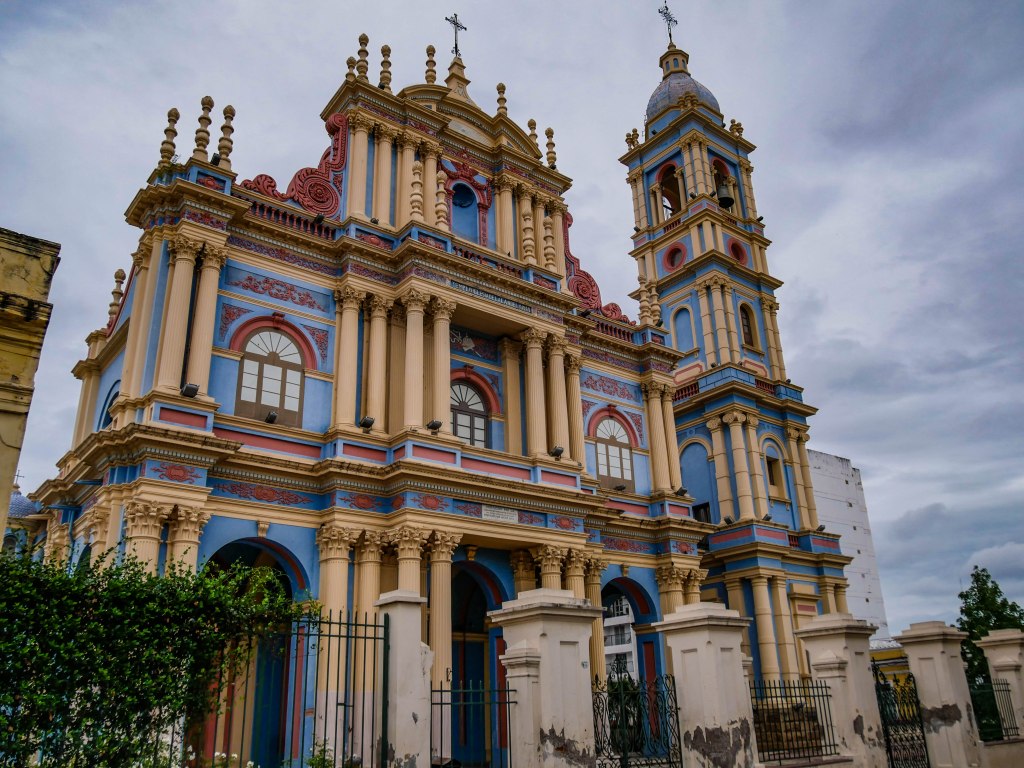
Salta is nicknamed La Linda (the beautiful). We can’t quite understand this just by looking at the city. While observing the many pictures in the shop windows of the tour operators, we get the idea that La Linda must refer to the whole province.
Therefore we spend only little time in the city itself and want to hitchhike to the neighbouring province Jujuy to the small village Purmamarca. However, our efforts to draw attention to ourselves at the roadside are not rewarded and so we later get into the bus, which ends up 3 hours later in Purmamarca. On the way we observe the increasing change of the landscape, which is characterized by the drought and has many cacti.
Purmamarca (23. – 26.02.2020)
In the small village of Purmamarca begins the Quebrada de Humahuaca, a valley that is characterized by many colorful mountains and stretches about one hundred kilometers north to Humahuaca. Normally the place is a bit touristy but still quiet and relaxed, but now it is carnival and the place is full of Argentineans (mainly from Buenos Aires) who celebrate the festivities. First we find accomodation by chance on a hippie campground. Unpierced, without dreads and in plain, functional clothes we stand out so much that we don’t feel very comfortable and change the next day.
A real, omnipresent highlight of the village is the Cerro de Siete Colores – the mountain of seven colours. So we get up early, walk to a small view point and enjoy the view – of course with mate.

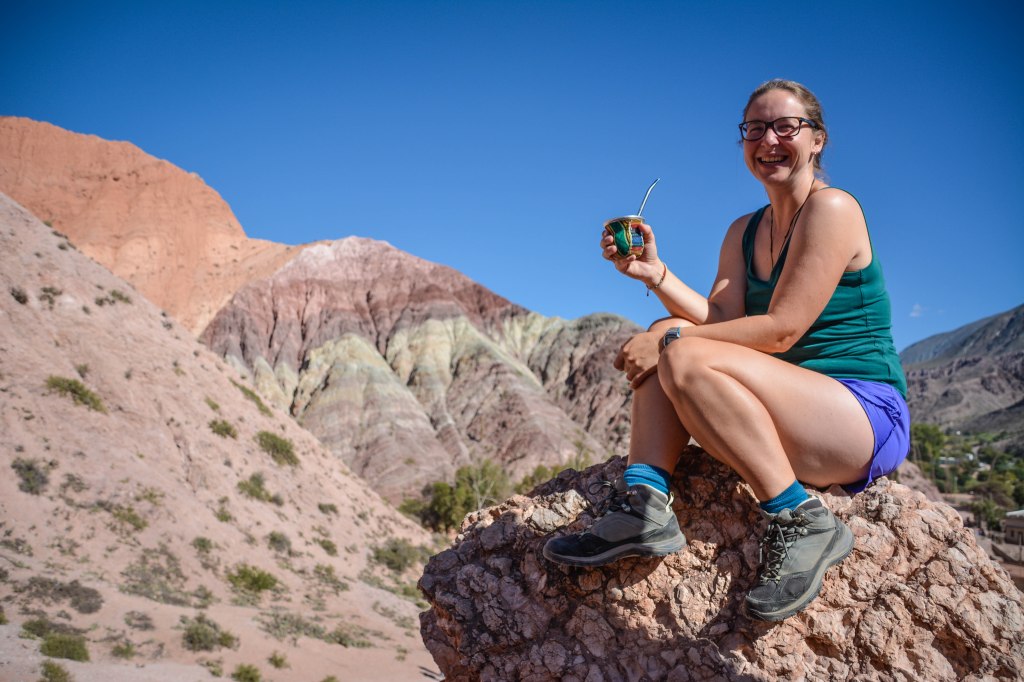



When we stroll through the village centre the next day, through the carnival celebration, we meet by chance the two Swiss Patrik and Beatrix again, whom we already know from Puerto Natales. Of course this has to be celebrated and so we get the Argentinean national drink – this time not Mate but Fernet Branca with coke and celebrate the carnival as exuberantly as the Argentines do.
It is part of the Argentinean carnival, with throw around spray foam and tallow. When we arrive at the main square, a small Argentinean suddenly stands in front of Lucas and tells him to cover his beer can. It is done as it is said and seconds later Lucas has a complete bag of tallow powder in his face. Again and again we are shot with „snow“, as the spray foam is also called.

After the evening was long and the next morning was accordingly not spent very actively, we come crawling out of the tent in the afternoon – the carnival still continues, but this time we are rather passive spectators.

From Purmamarca we take the bus and continue our journey through the north of Argentina via Humahuaca to Iruya.
Iruya and San Isidro (26. – 28.02.2020)
After a bus ride of more than three hours from Humahuaca, during which we drive over a 4.200 metres high pass, we arrive in the small place Iruya. It is already dawning and so we start looking for a place to stay for the night. Actually we want to camp, but we have no more gas and at the campground there are only grills and fireplaces. But since we want to reduce the consumption of meat anyway – despite great taste and outstanding quality – we decide against camping and later end up in a small family accommodation. There we get to know a group of Argentine students who have similar plans as we do.
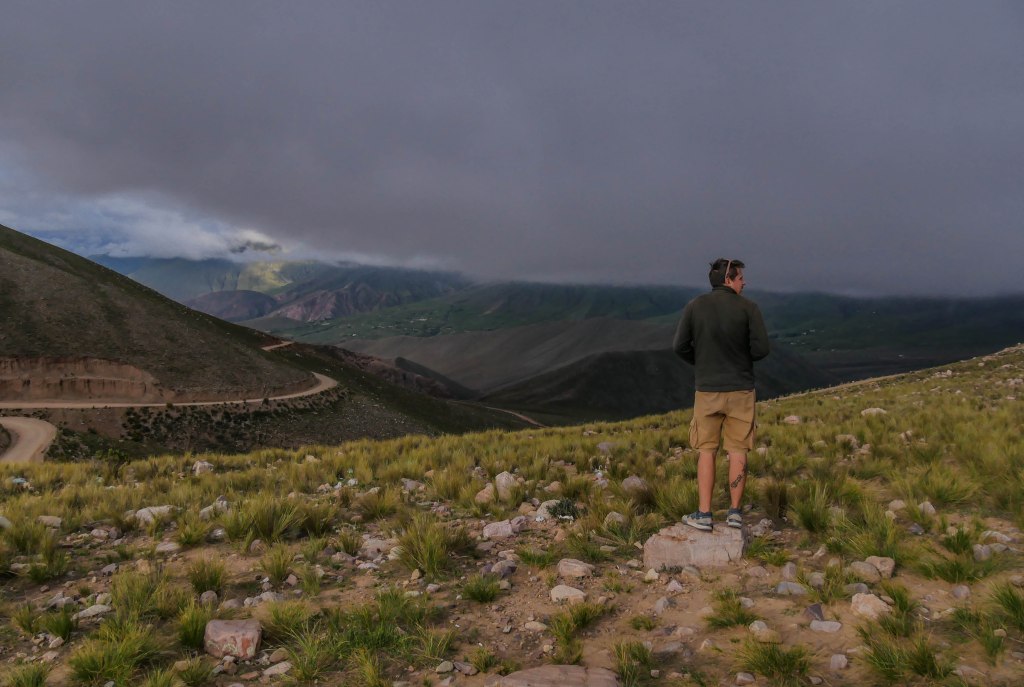

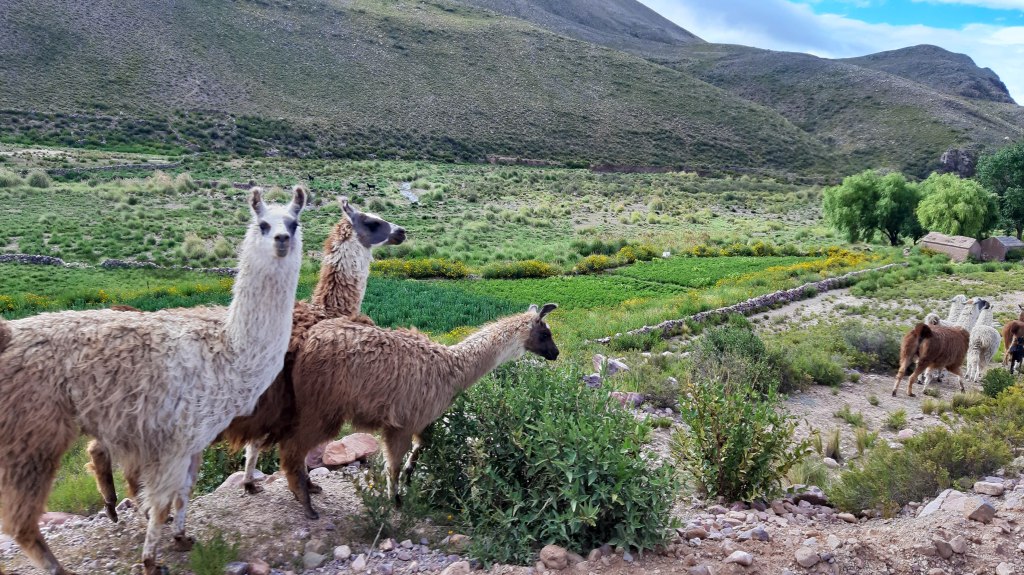
Iruya is not located in the Quebrada de Humahuaca, but in the neighbouring province of Salta. Nevertheless the landscape is quite similar – colourful mountains, deep canyons and mountain rivers. So we decide to do a half-day hike to the micro village San Isidro.
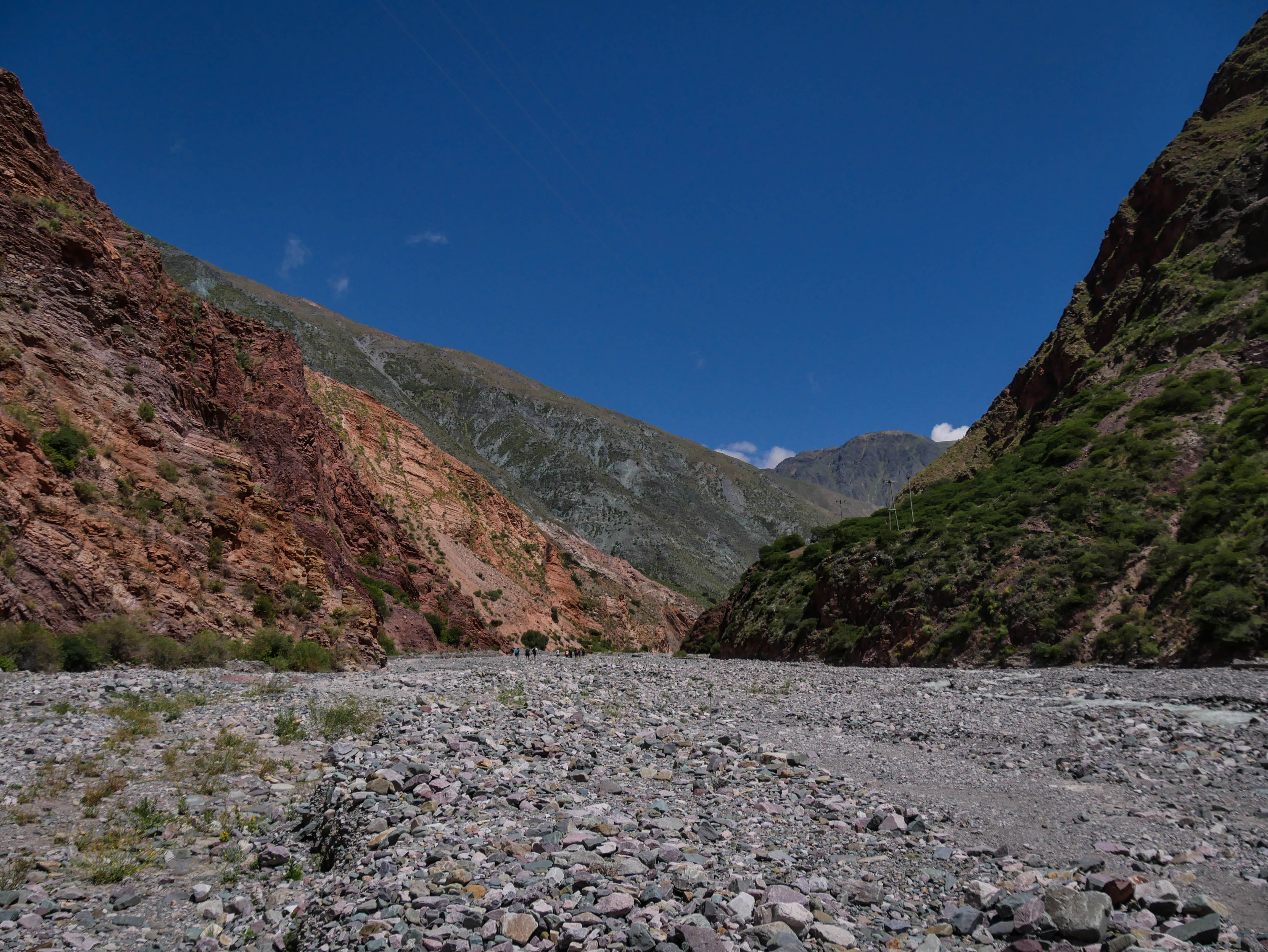
Since it had rained a lot in the last days, the hike is not easy, because we have to cross the river multiple times. We meet a group of hippies we already know from the hippie campground in Purmamarca and form human chains at some places so that crossing is easier with the strong current.
Arriving in San Isidro, we first check out the village from the highest point and then stroll through the village centre.


We wonder what life is like in such a remote place and observe that large parts of the land in the village are used for agriculture and often we see signs on the houses indicating that they are hostels for tourists. Some of them say that the sky here is supposed to be especially beautiful at night because of the low light pollution. But we cannot convince ourselves of this, because we planned to hike back the same day. On the way back we count how often we cross the river. Depending on how we count it is 13 or 15 times.

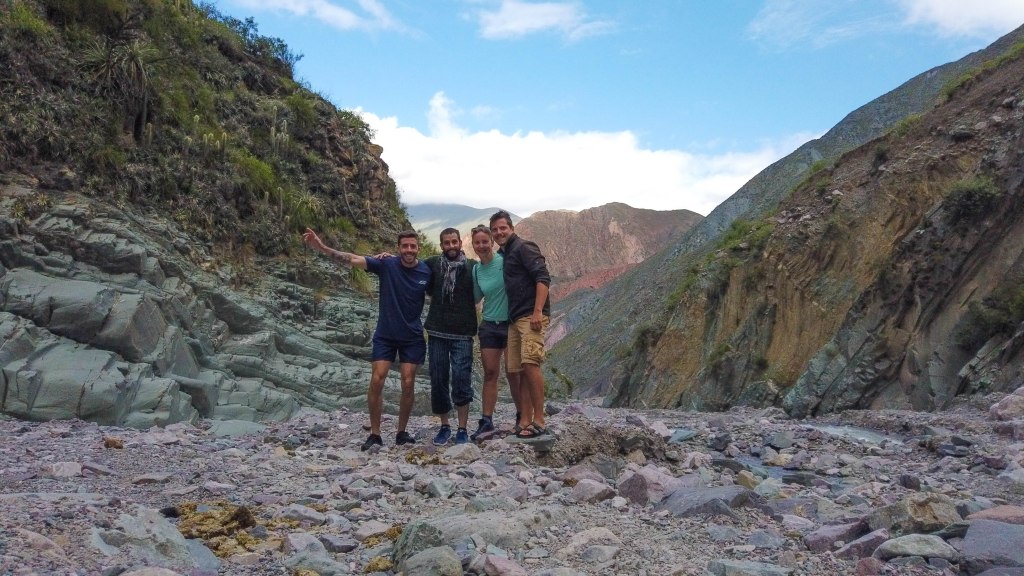
Before we go back to Humahuaca by bus the next day, we have a look around Iruya and enjoy the great view of the mountain village.
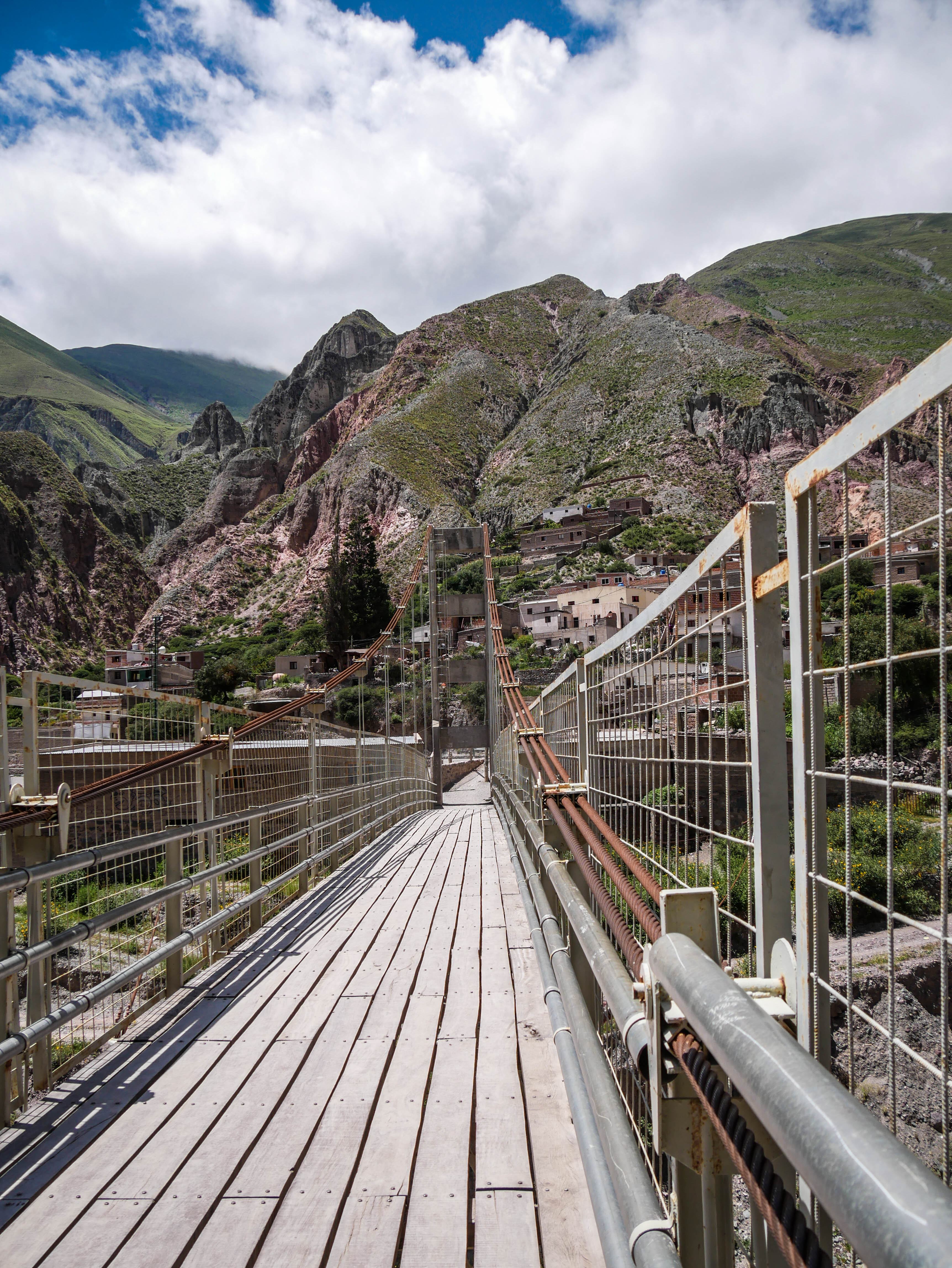
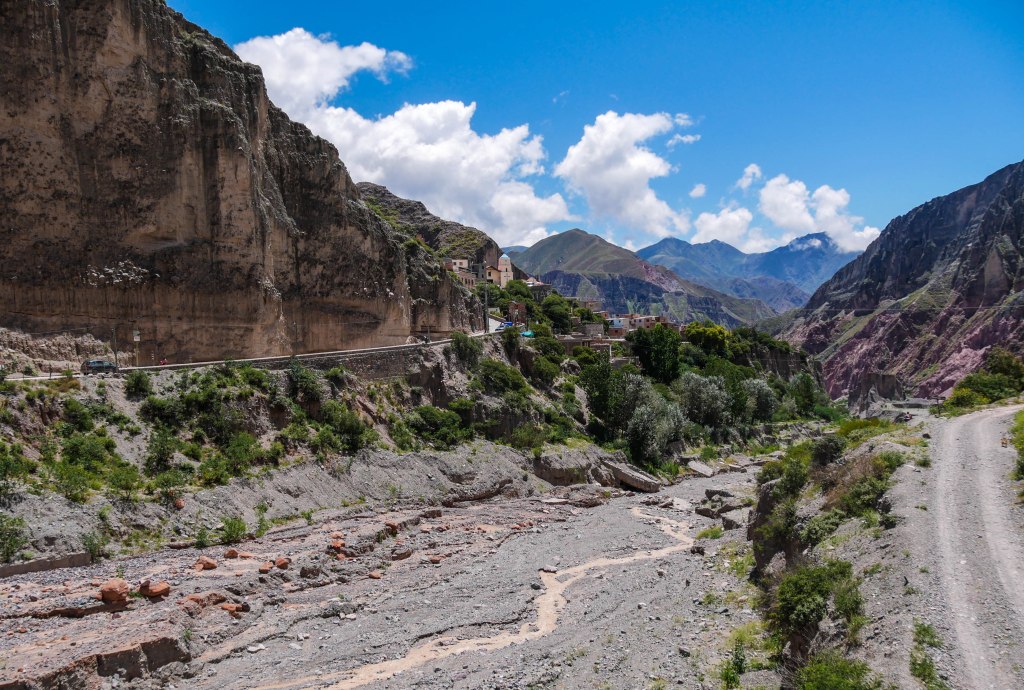


Humahuaca (28.02. – 02.01.2020)
We spend three days in Humahuaca. We use them, among other things, to have the zips of our tent replaced. Not only do they not work so well anymore due to their age, but especially in this dusty area they have suffered a lot. On the market street Diana talks to a man who leans against a post and is supposed to be a tailor. Indeed, he takes the tent and the new zippers (this reminds us strongly of Kyrgyzstan) with him and we pick it up some hours later at his home. Beside the new (falsly installed) zippers we also get a new hole in the tent wall and the attempt to sew it for free. The most important thing is that we can close everything again.
For the same day we also get a transport to the famous 14-coloured mountain – Serranía del Hornocal. This is a limestone formation. The sediment layers, whose colours range from green, yellow to red, are eroded here at the surface.
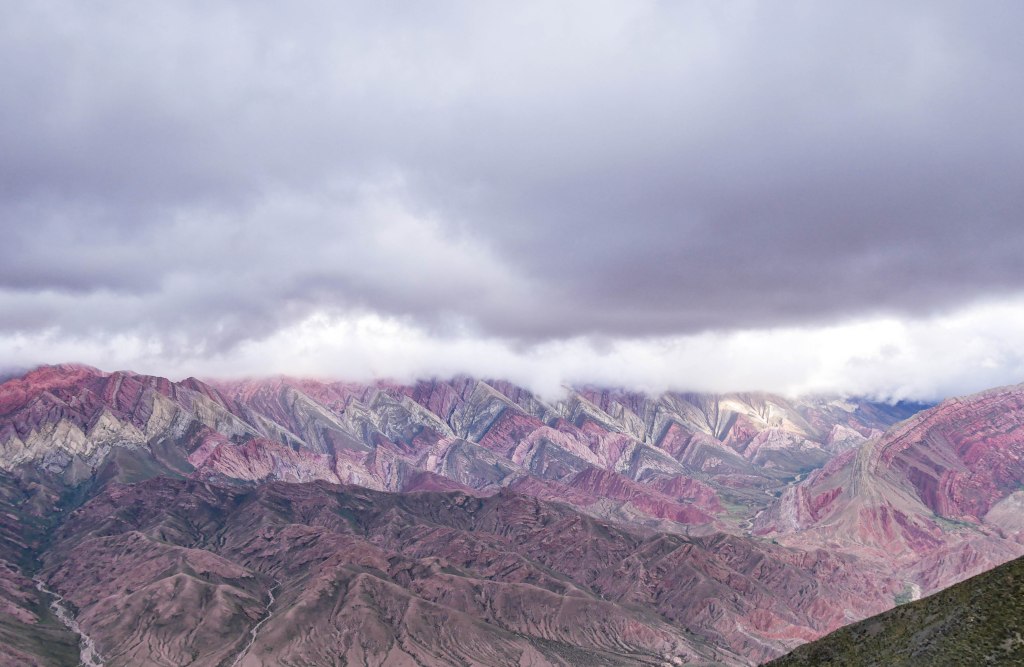

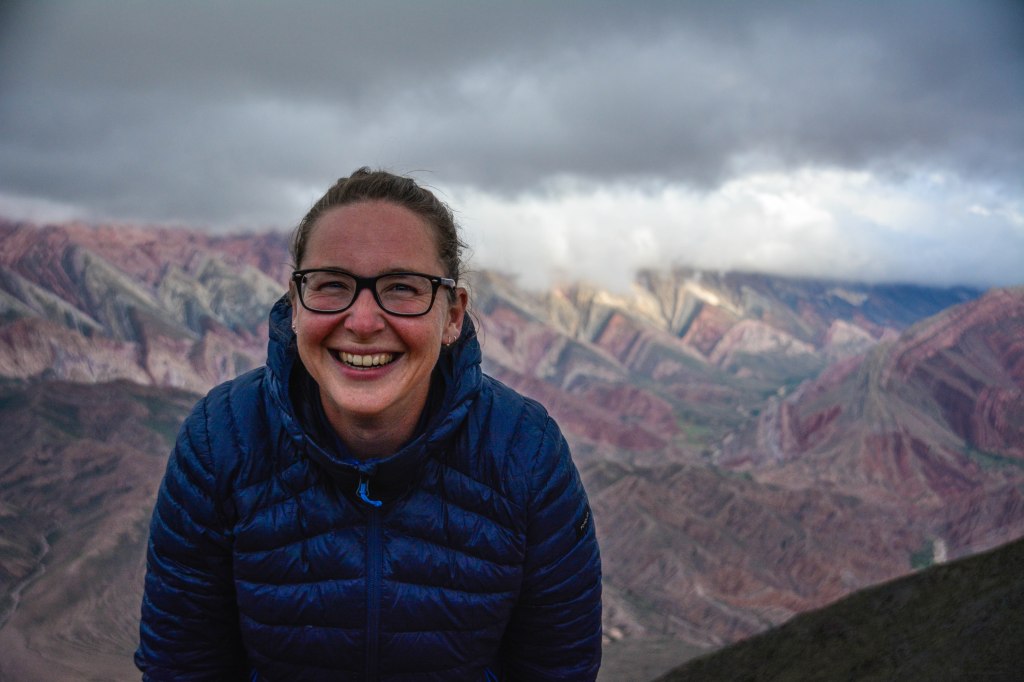

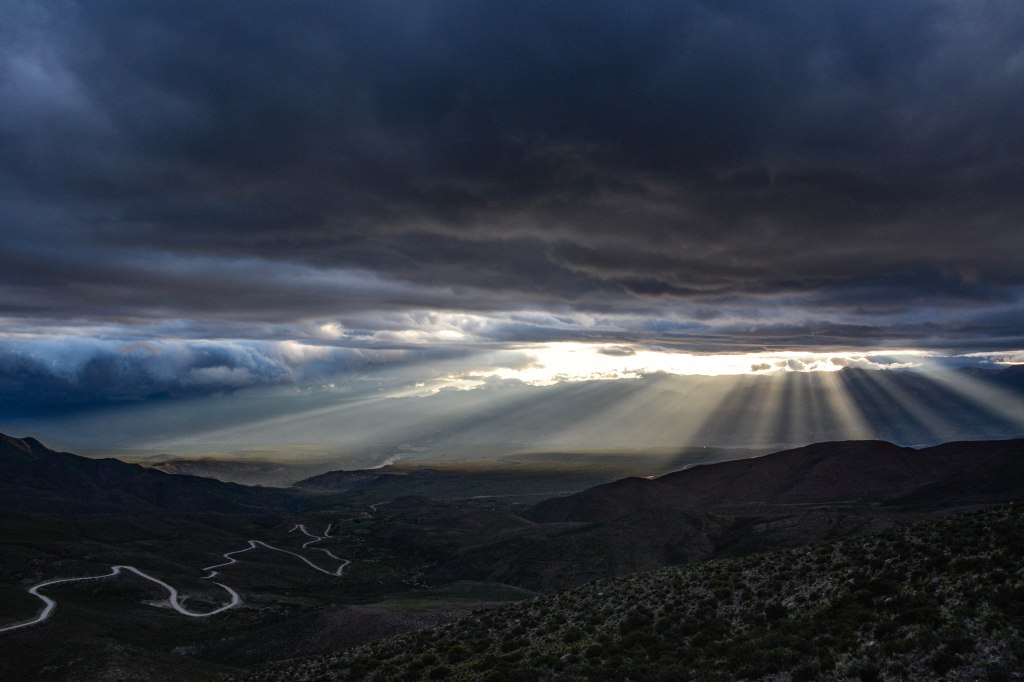
It is still carnival in Humahuaca and many trumpets and drums play loud carnival music everywhere (apparently always the same song) and the ringing of bells on people’s costumes is omnipresent. And here, too, plenty of tallow and spray foam is used.
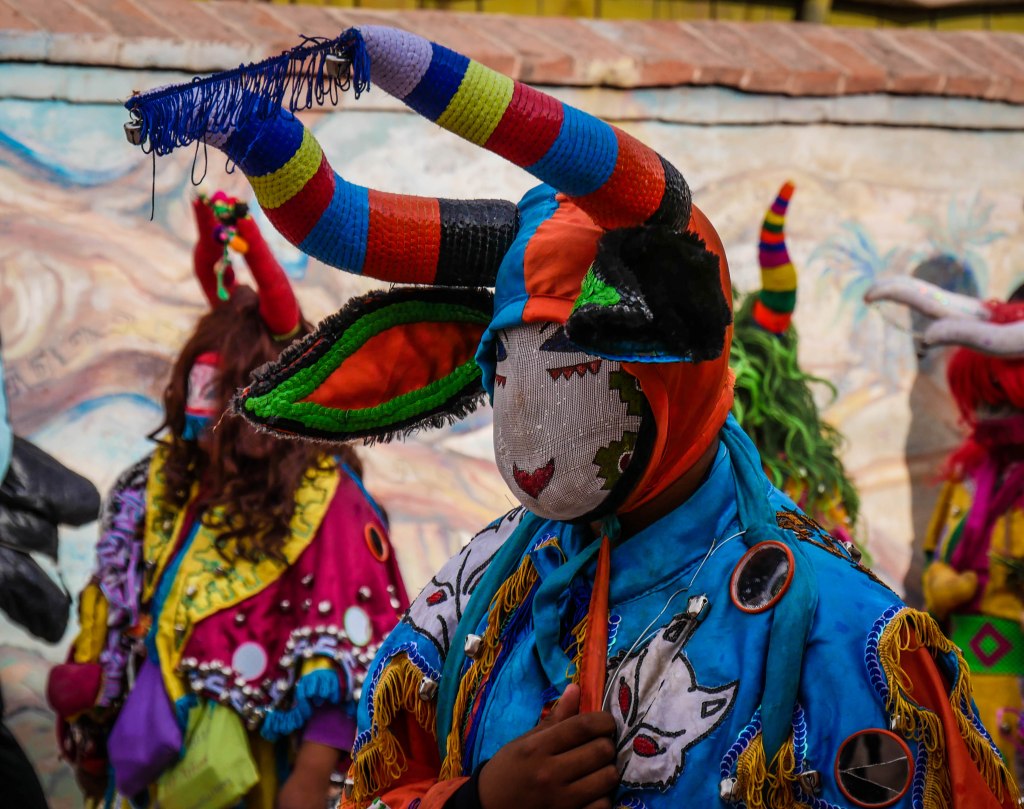
On our last evening in Humahuaca we go to the last street party before the carnival devils, as the traditionally dressed up figures are called, are buried until next year. In the crowd we meet the Argentinean student group with whom we shared accommodation in Iruya again and celebrate together.
Tilcara (02. – 03.03.2020)
The next day we will go to Tilcara. We visit the Pucará de Tilcara, an archaeological site where findings of a village of the Tilcara Indians were made.


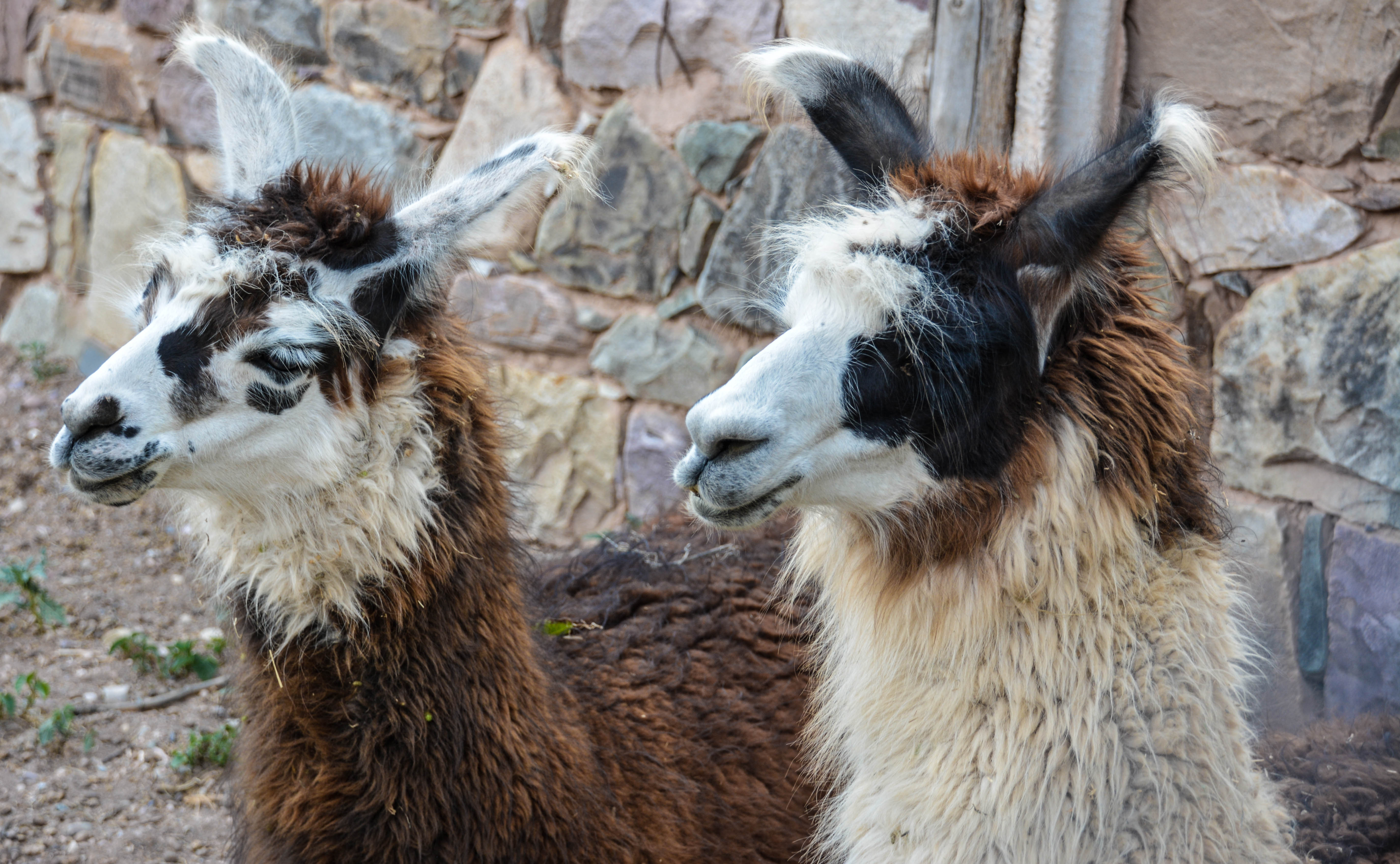

Purmamarca (03. – 04.03.2020)
The next day we take the bus from Tilcara back to Purmamarca, because we want to continue by bus to San Pedro de Atacama in Chile. This time we experience the village very calm and relaxed. Without the carnival bustle, the small alleys and traditional buildings, which are under UNESCO protection, come into their own much better. In the late afternoon we go to the viewpoint, which offers a stunning view of the colorful mountains behind the village.
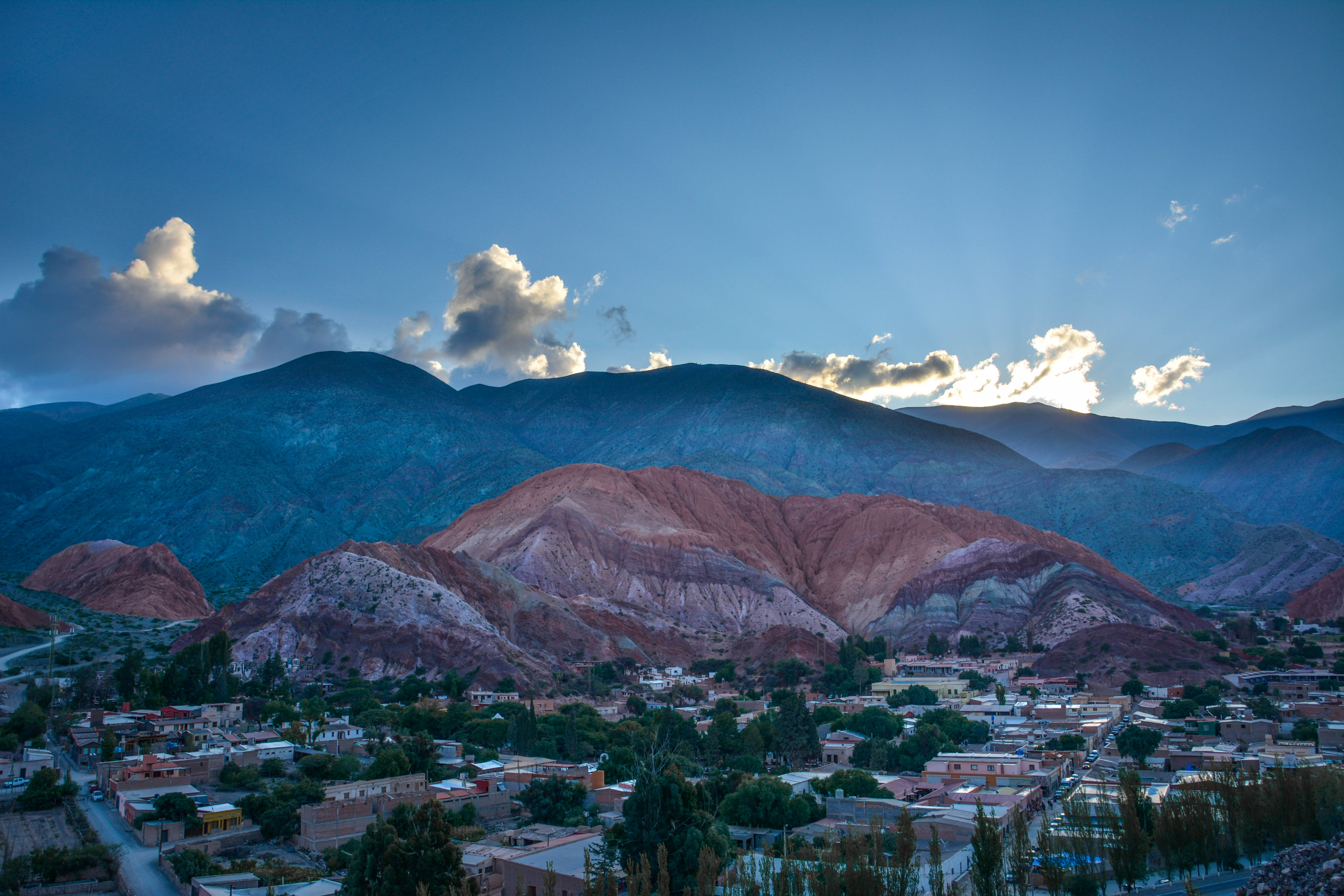
With this excellent view we review our time in Argentina before we head to our campground to get a few hours sleep before we take the bus at 03:40 am to the Atacama Desert.
In time we stand at the bus stop. But the bus doesn’t quite keep up with the time and is almost an hour late this morning. While waiting we have nice company though – a friendly and active Golden Retriever from the village joins us and keeps us on the go.
